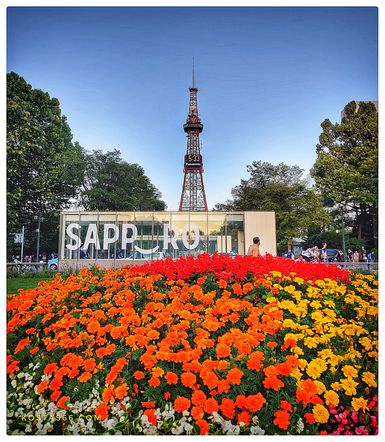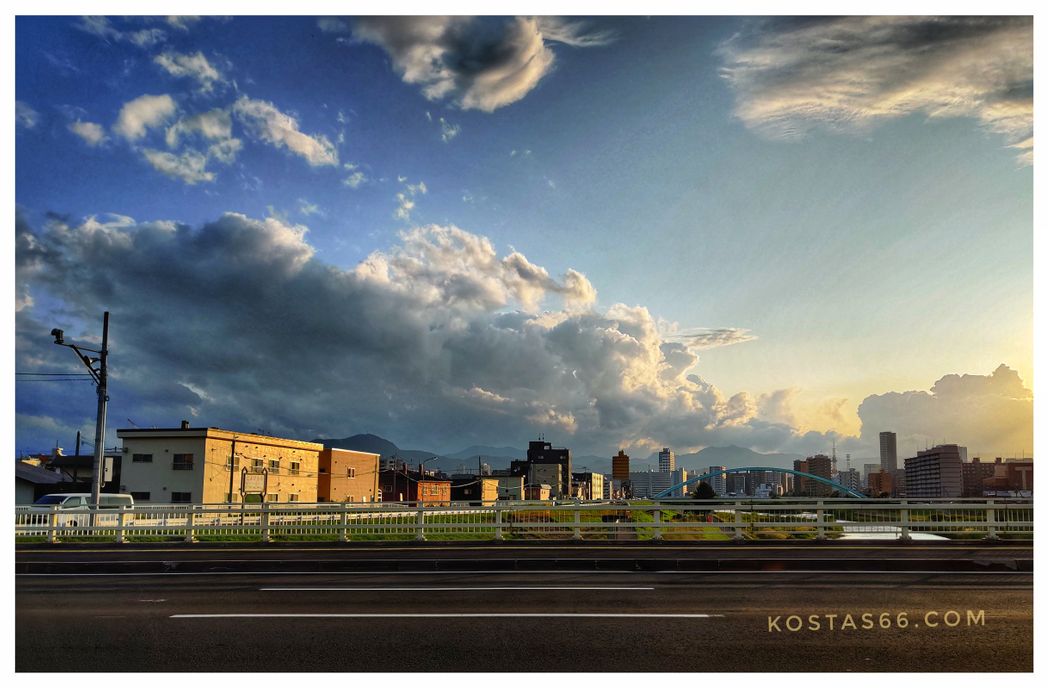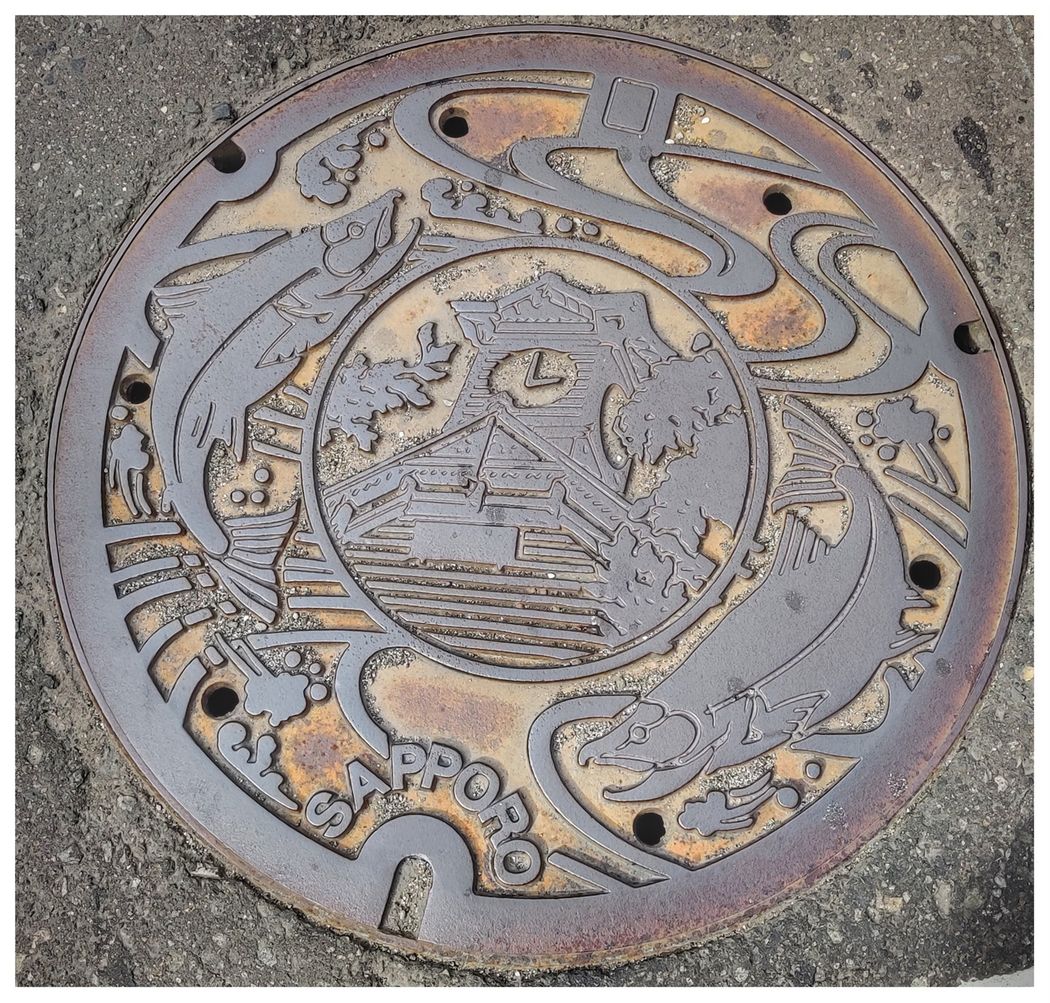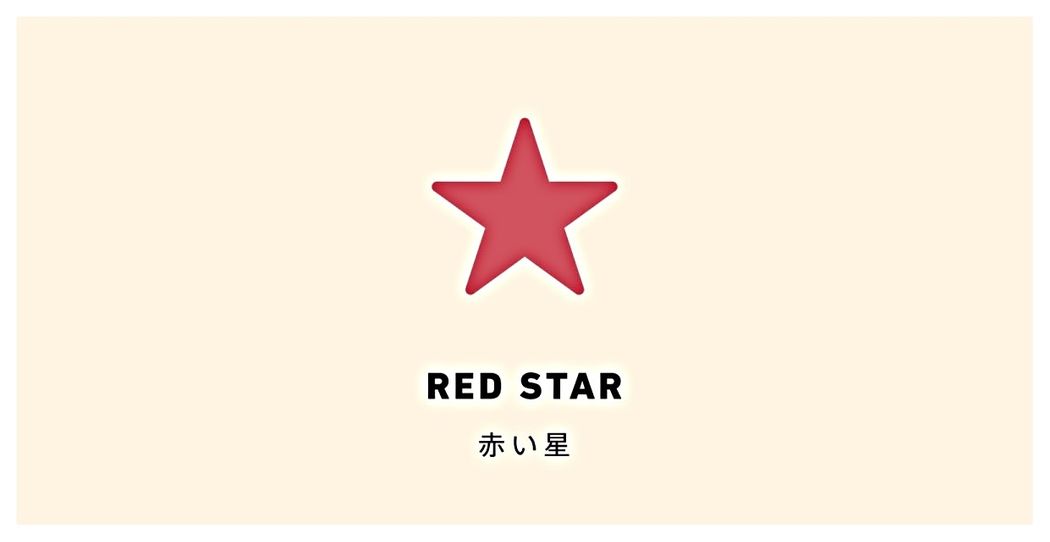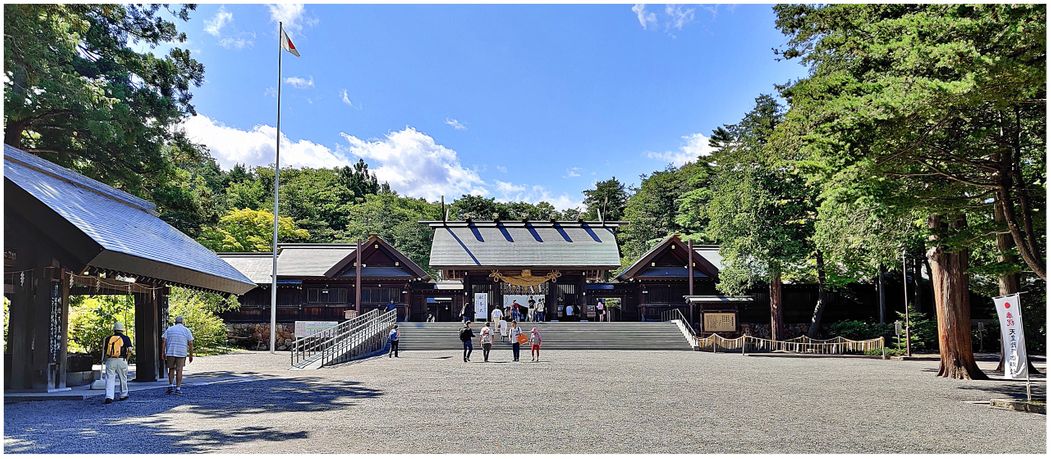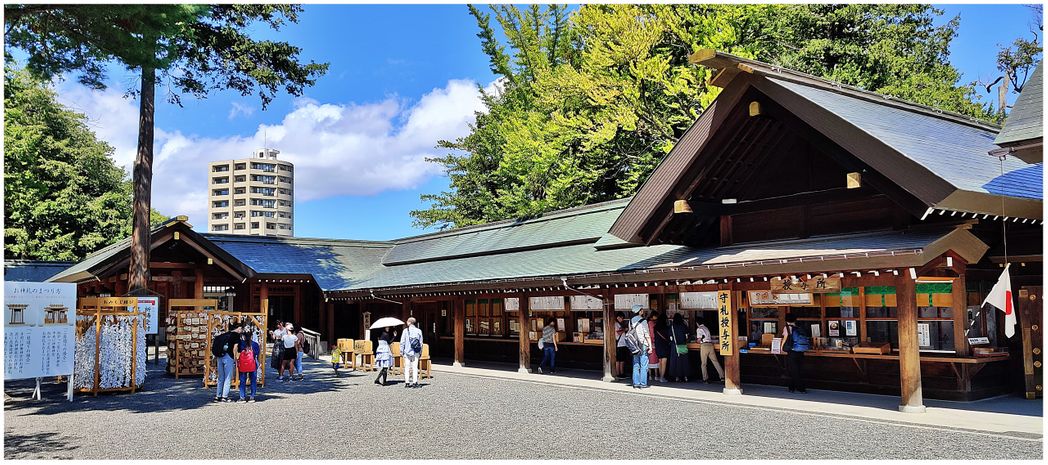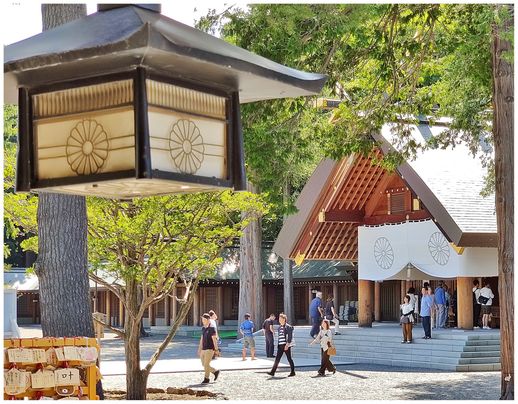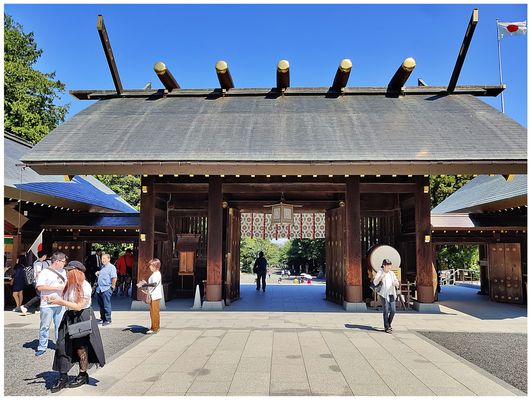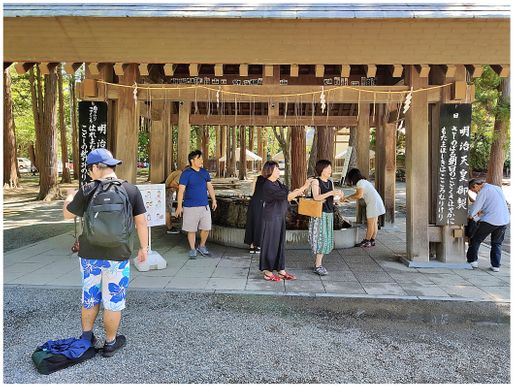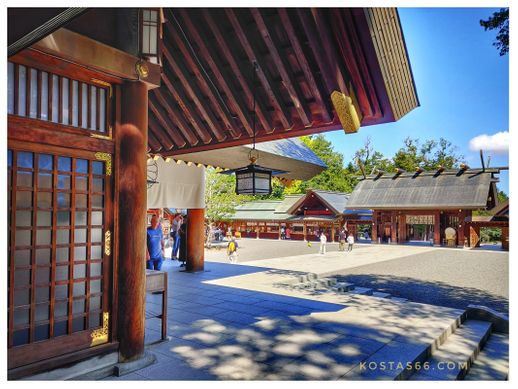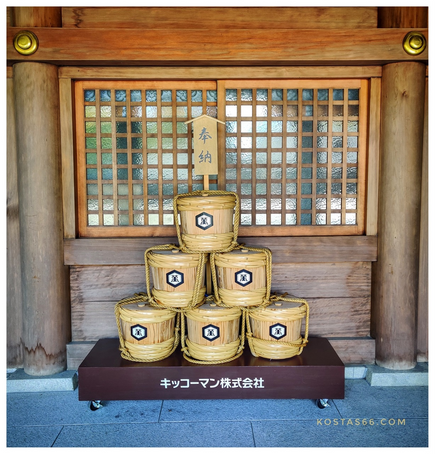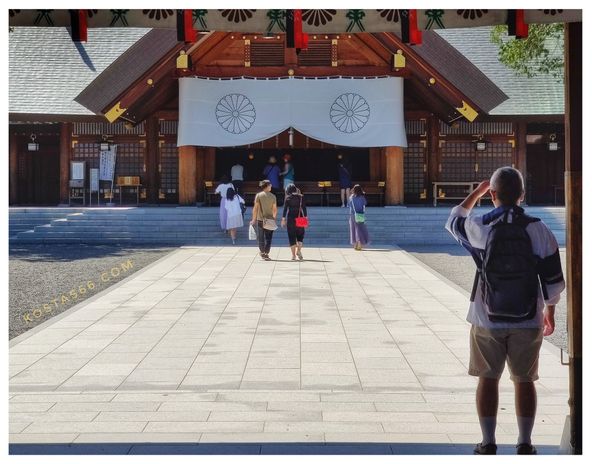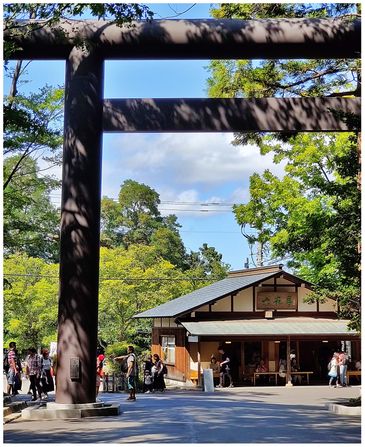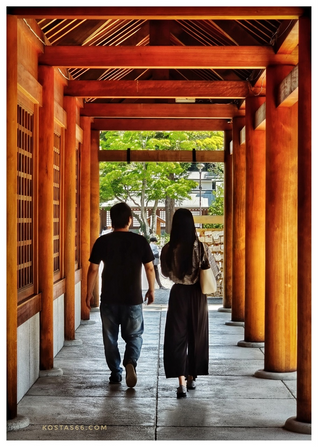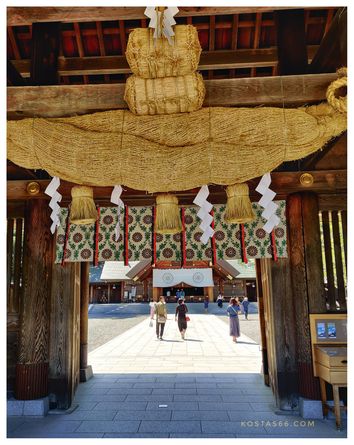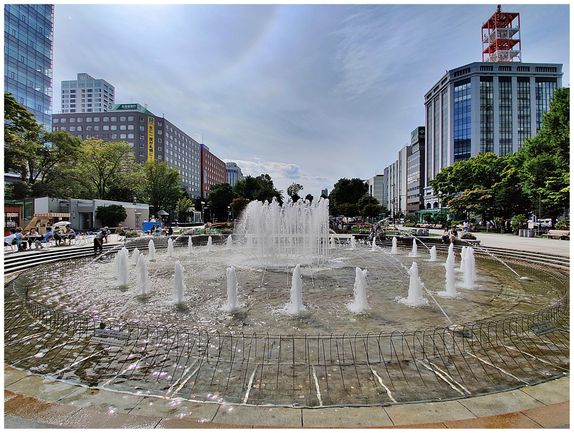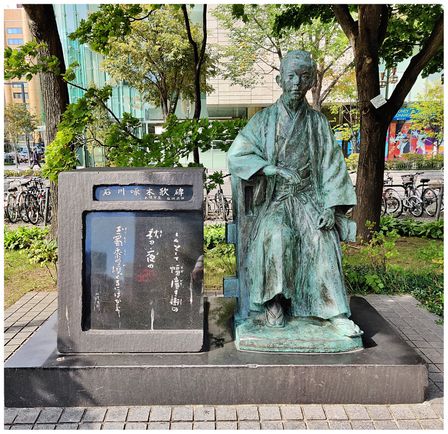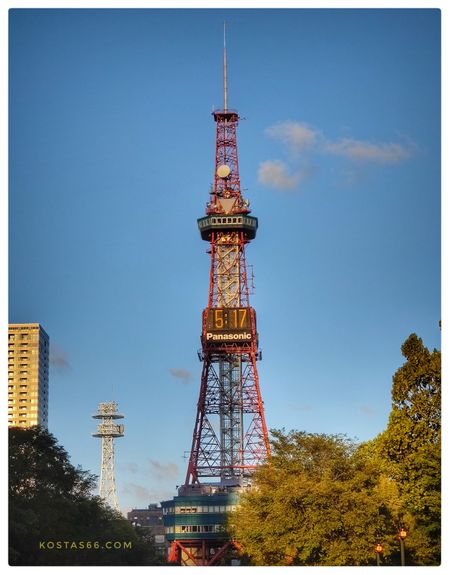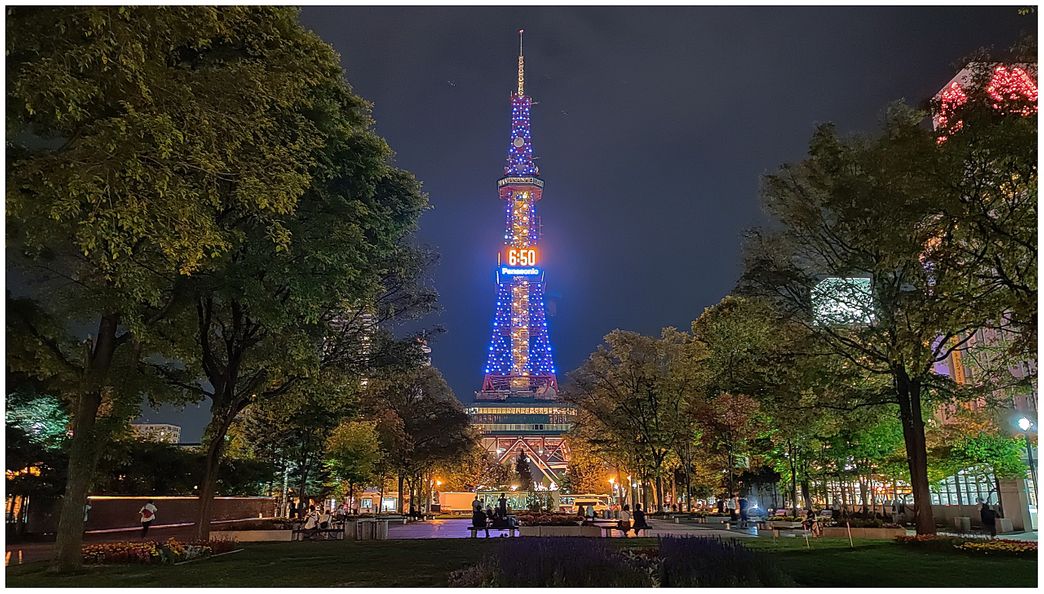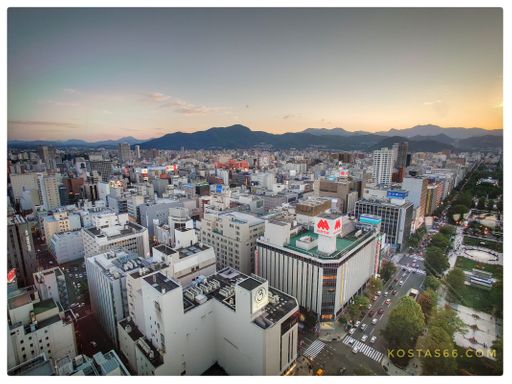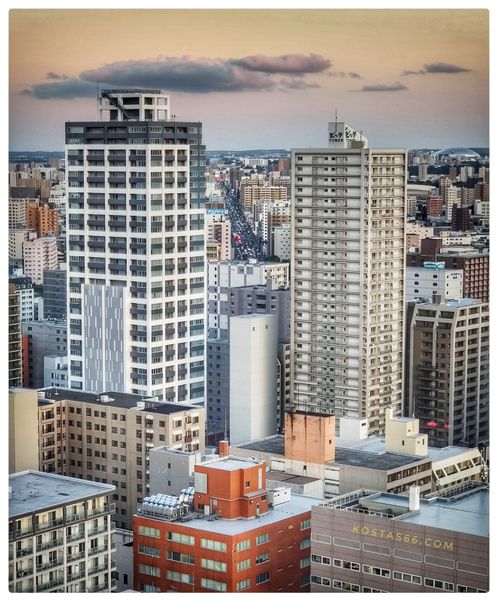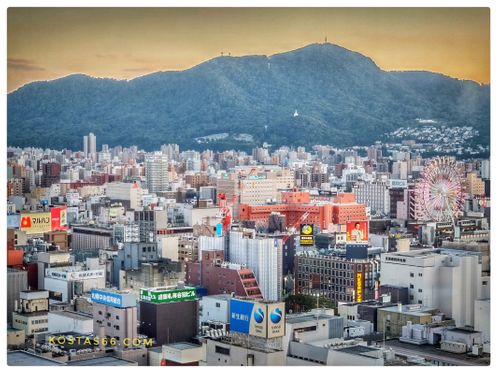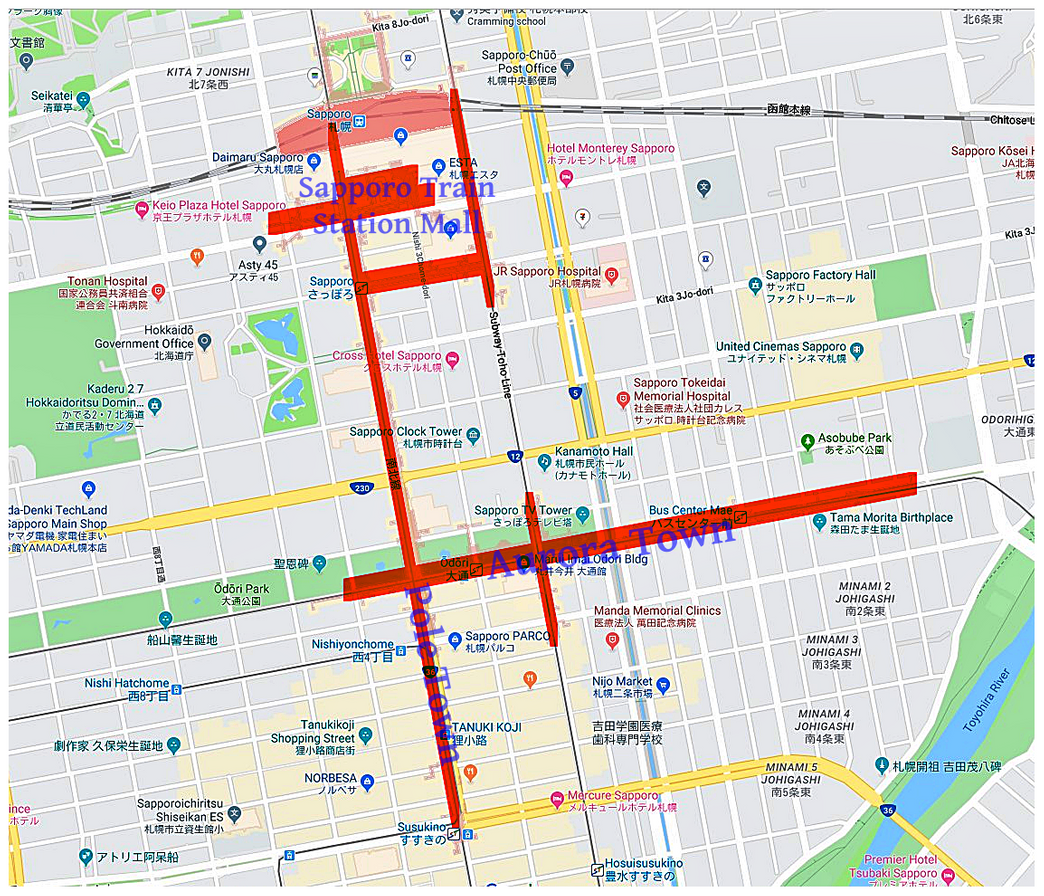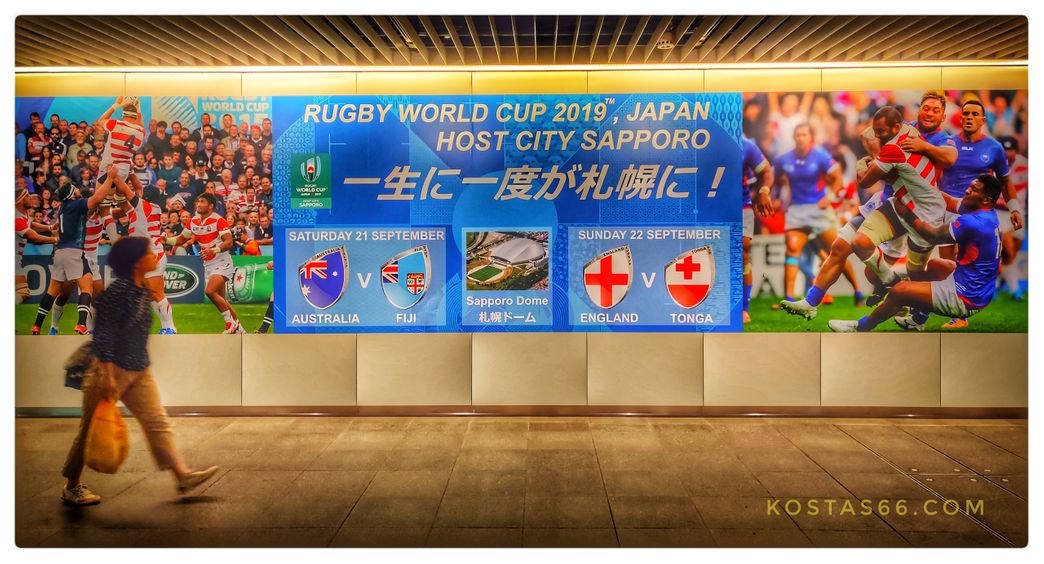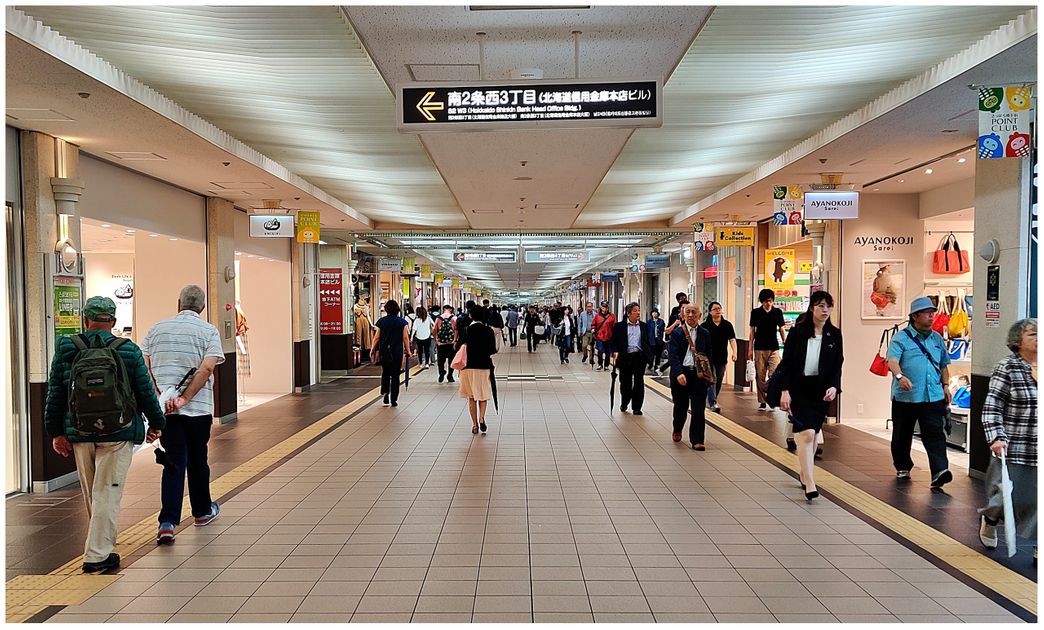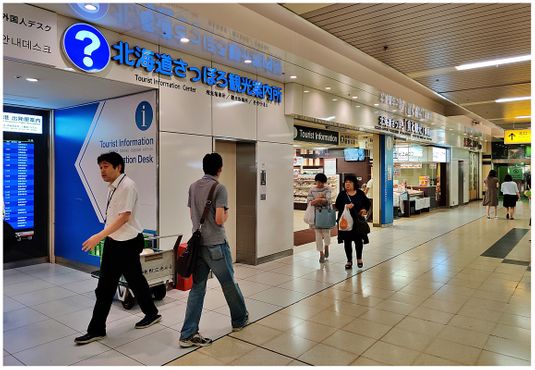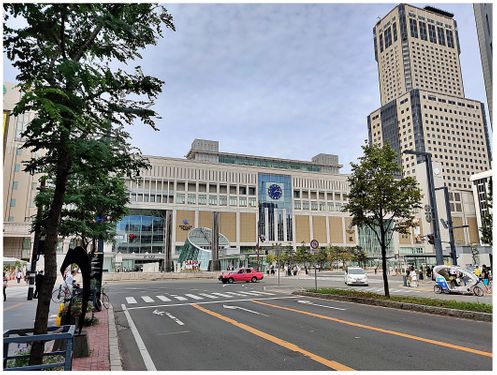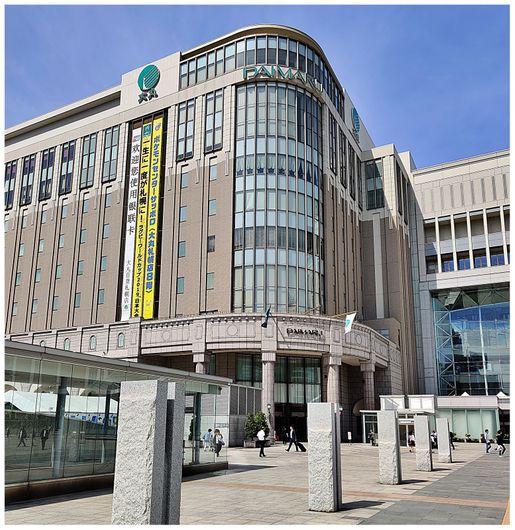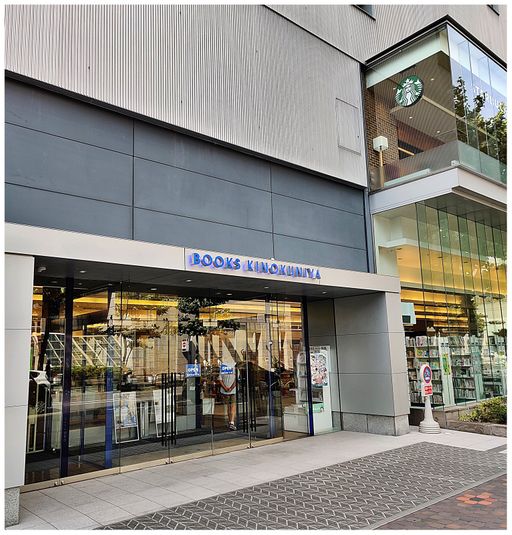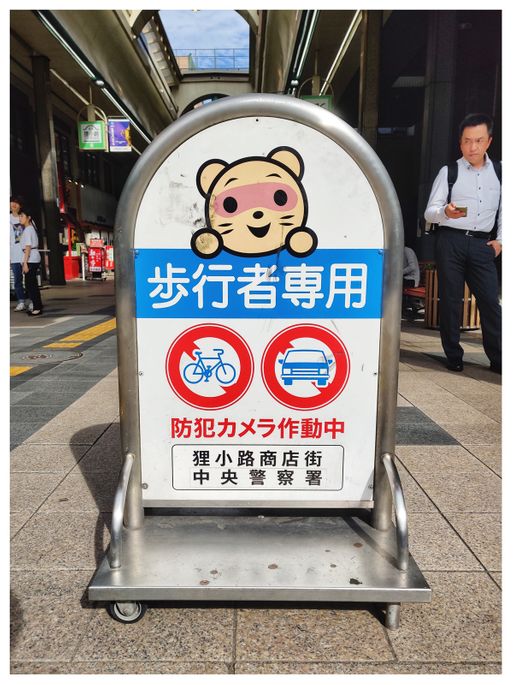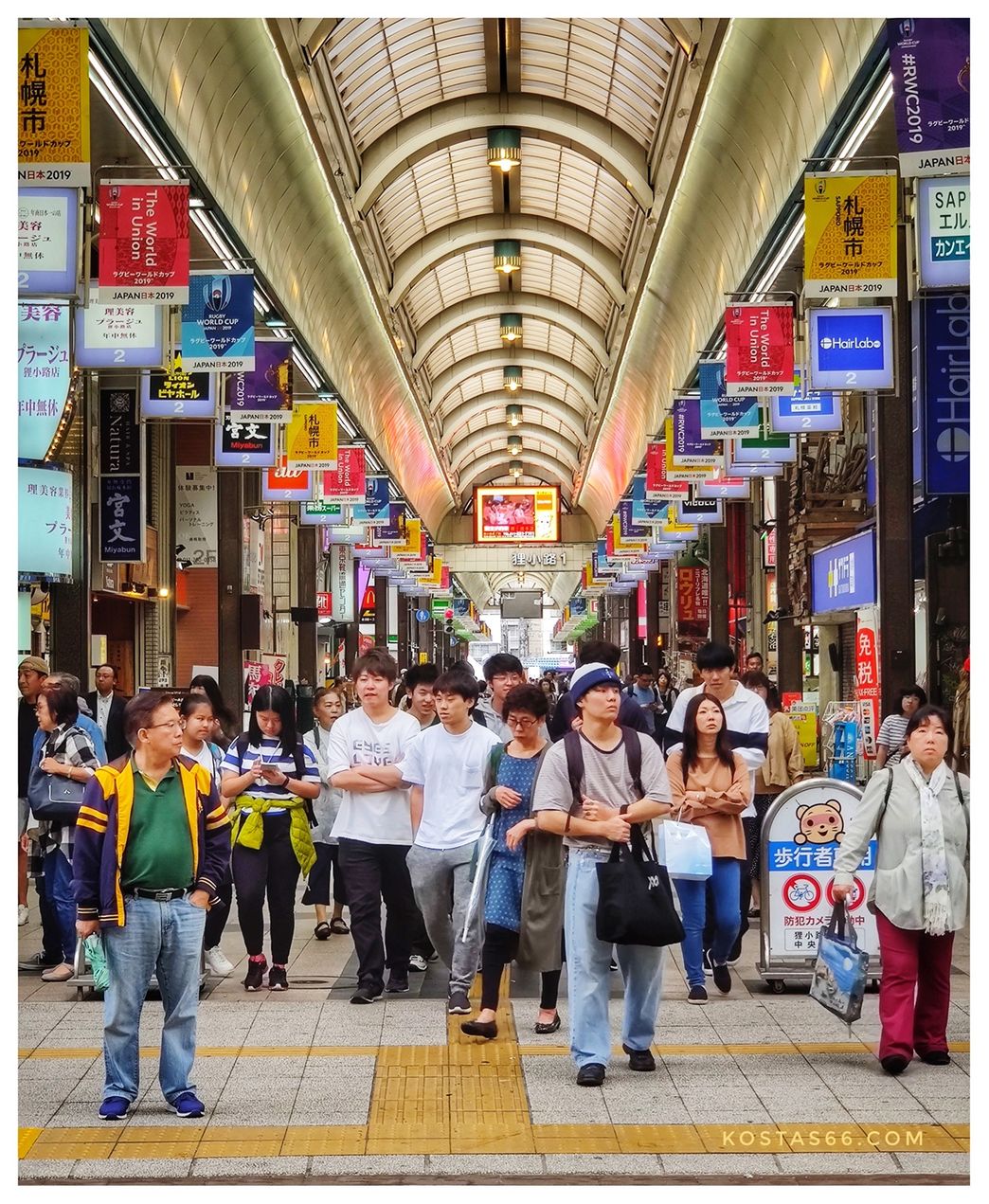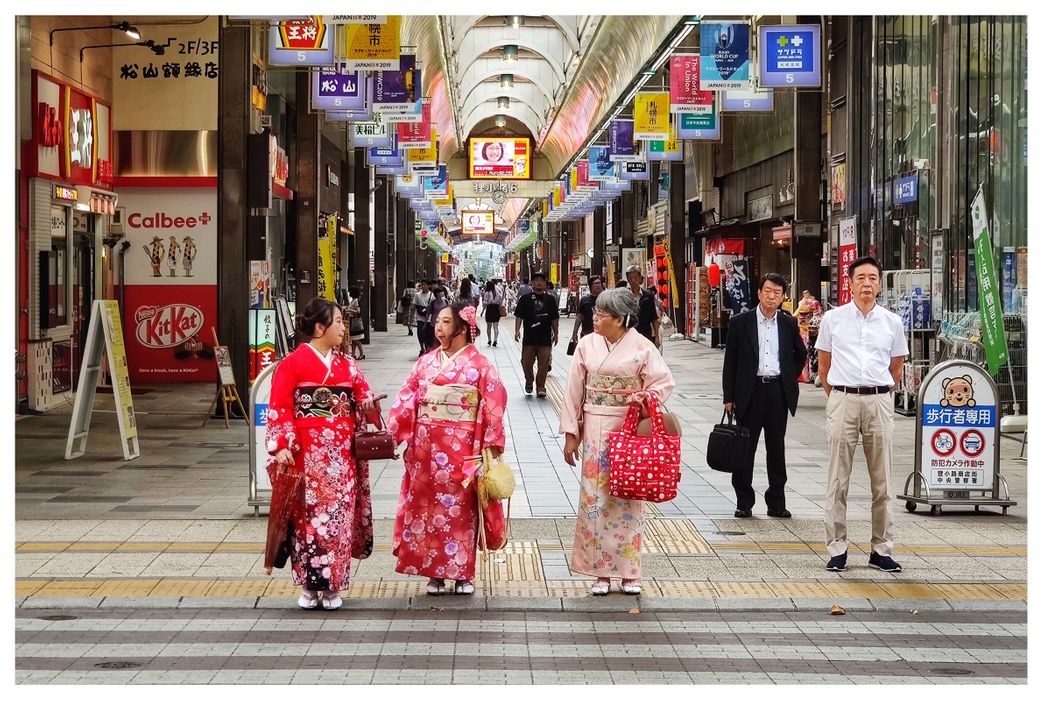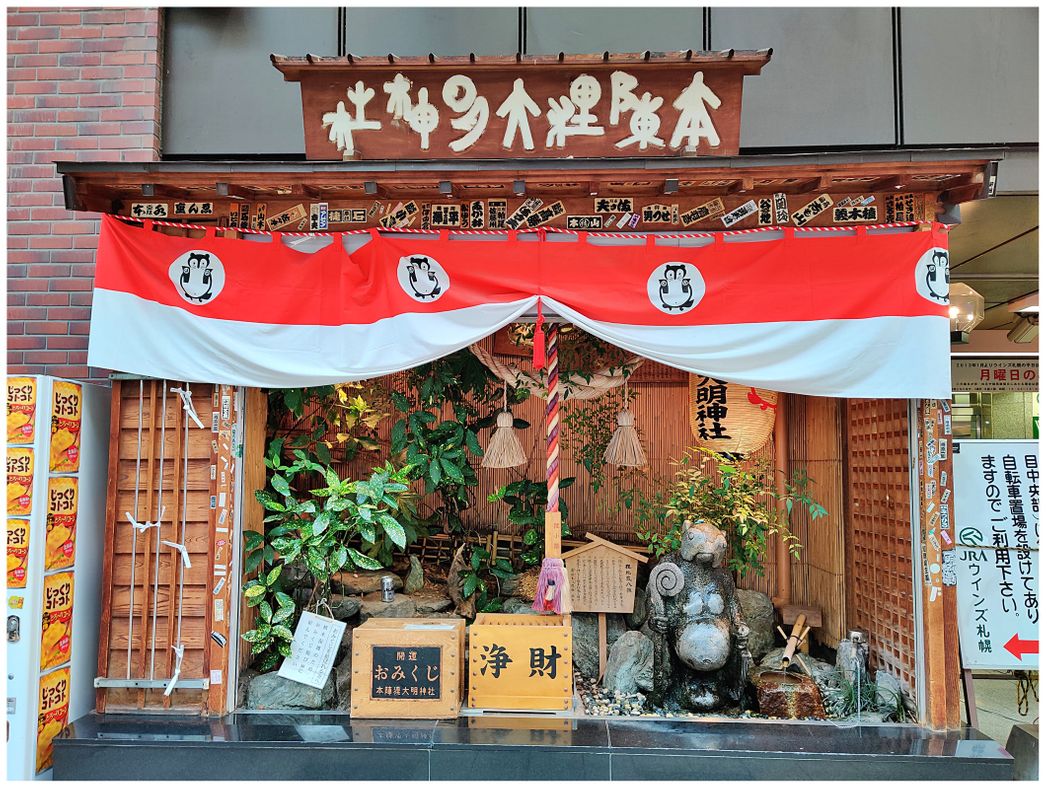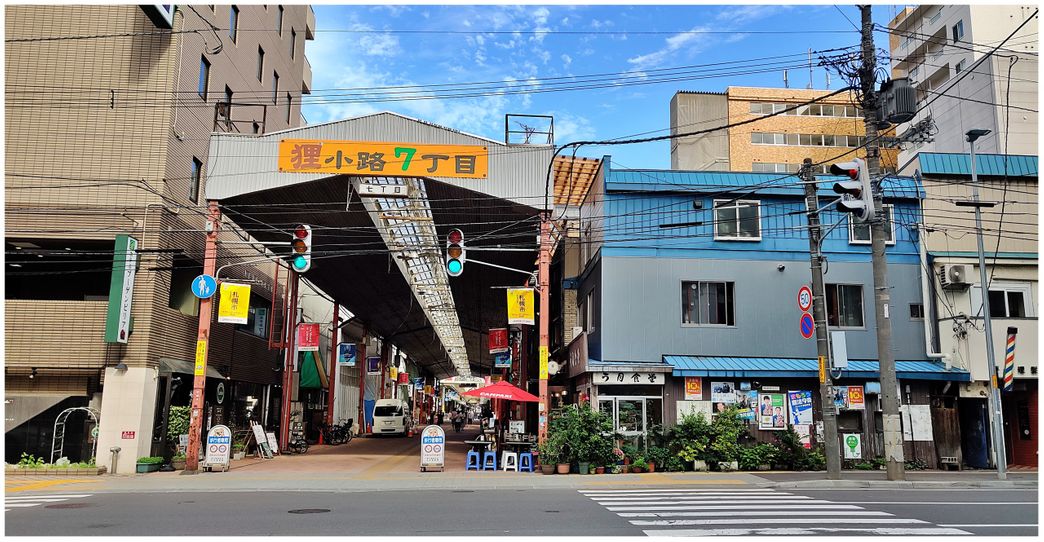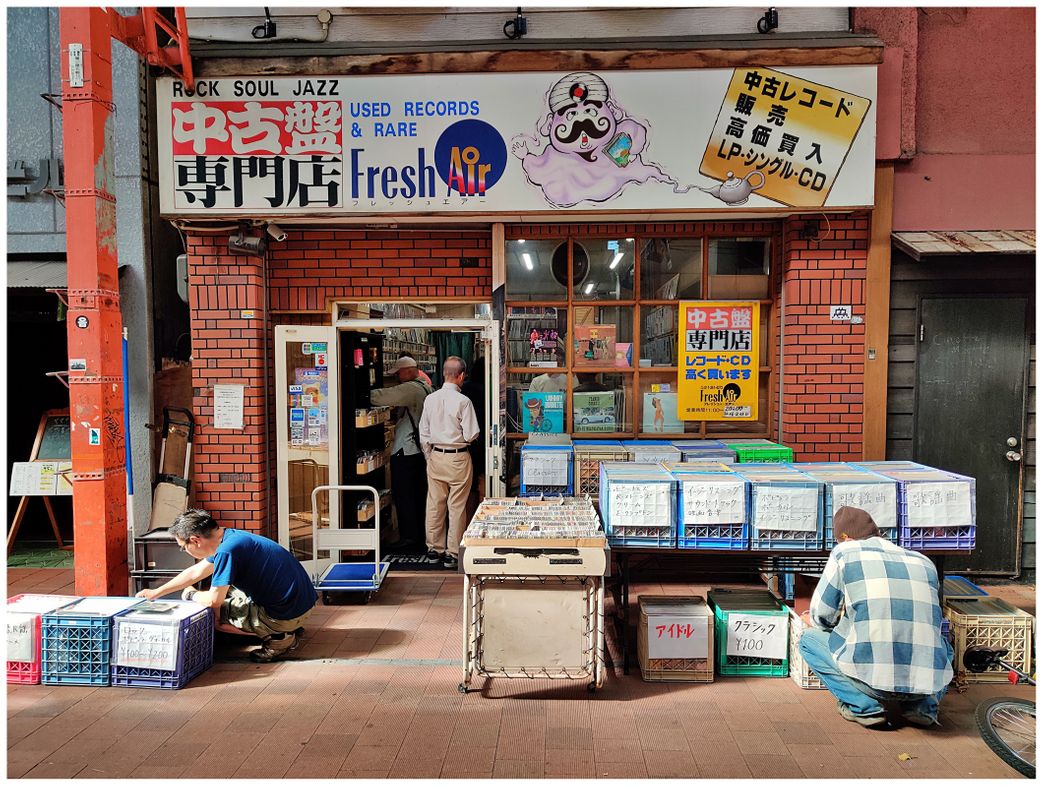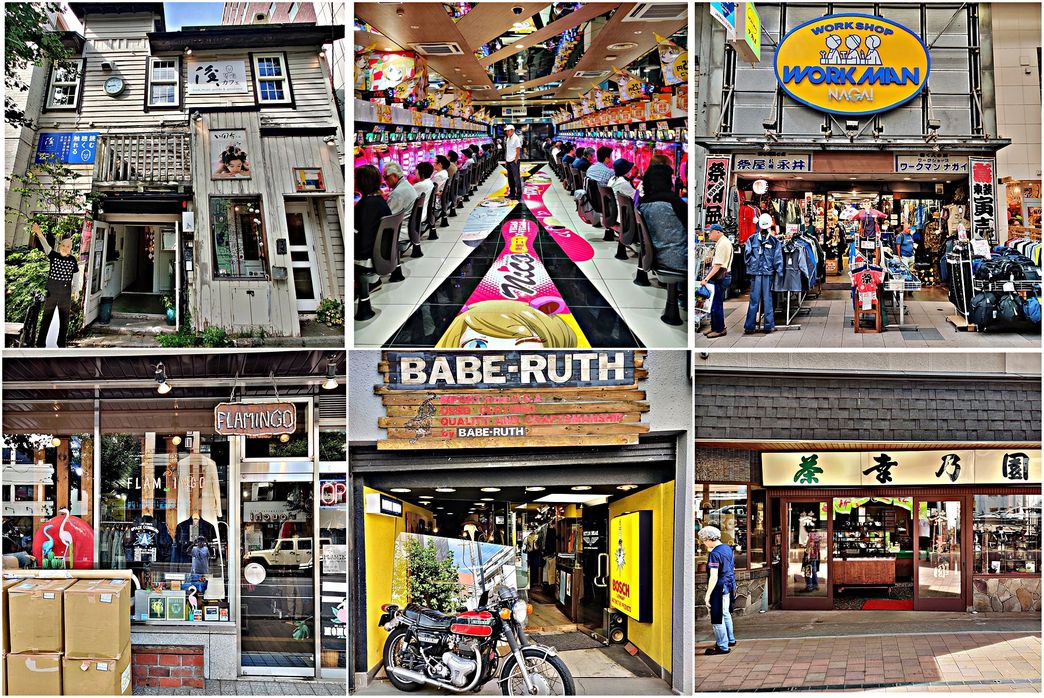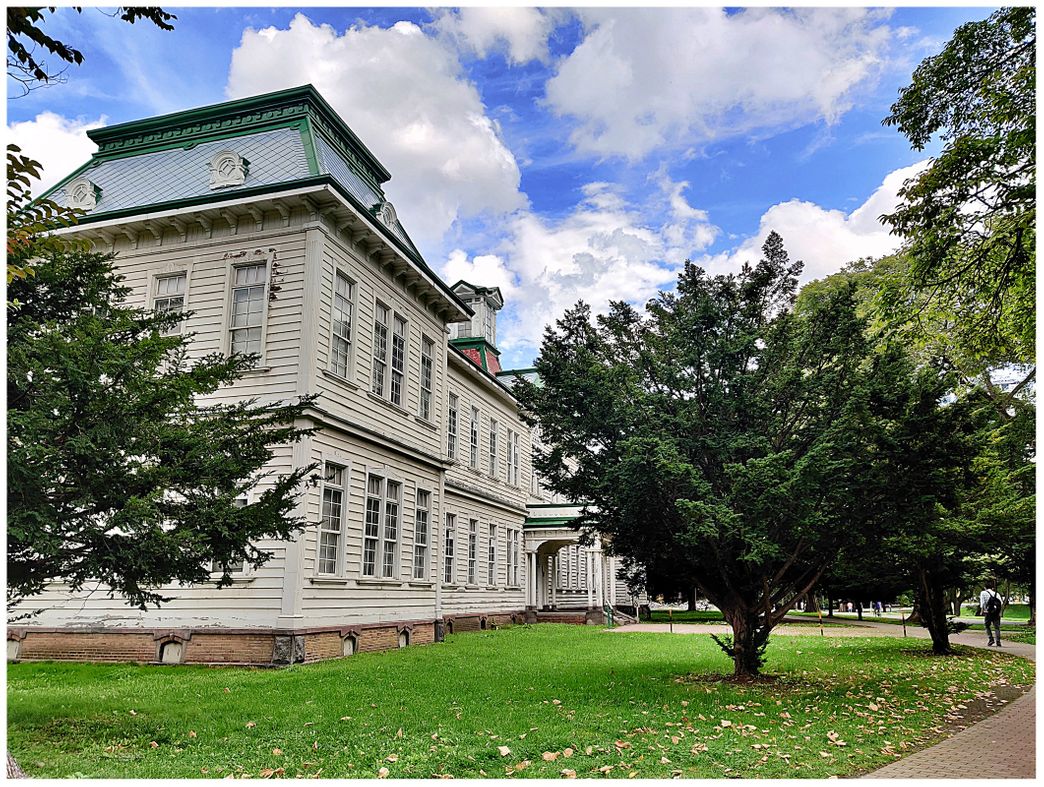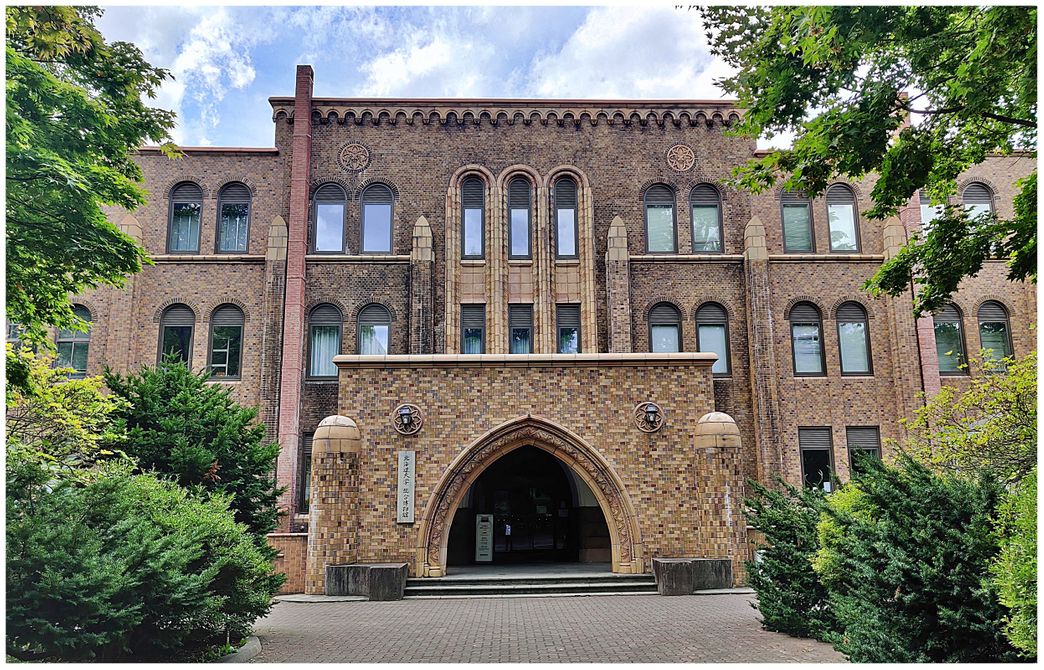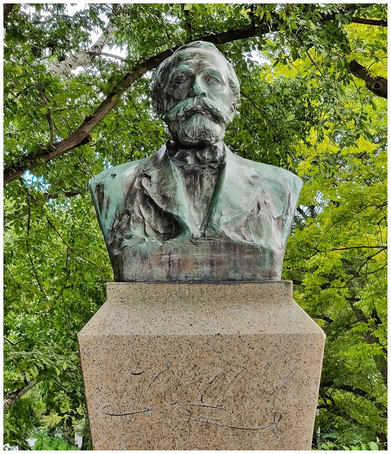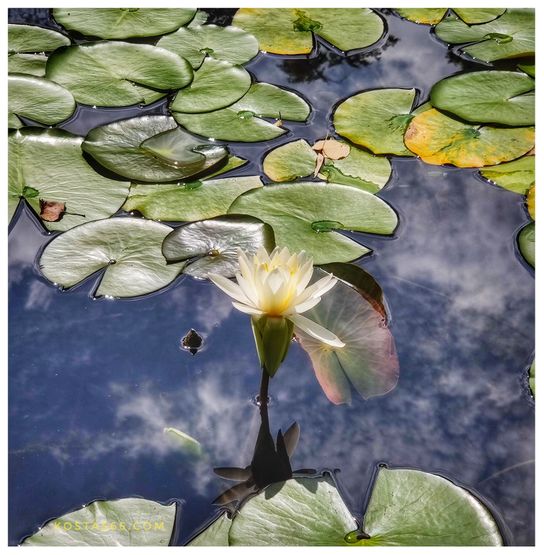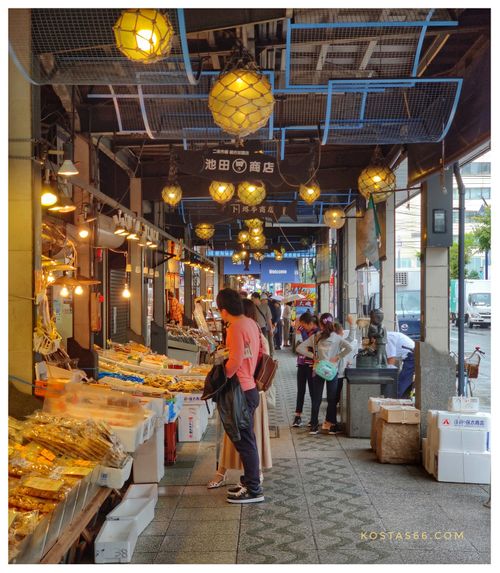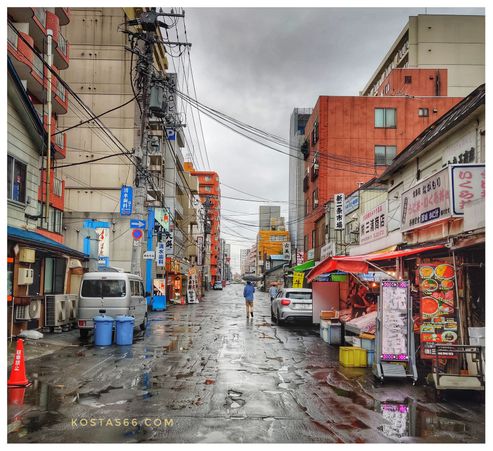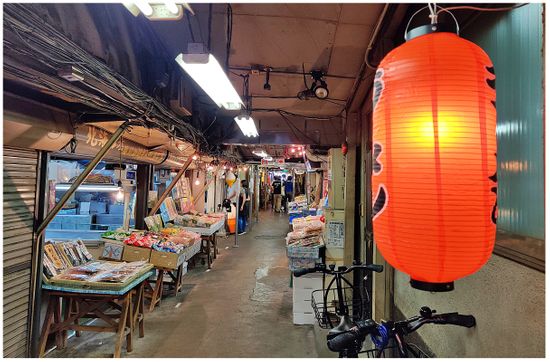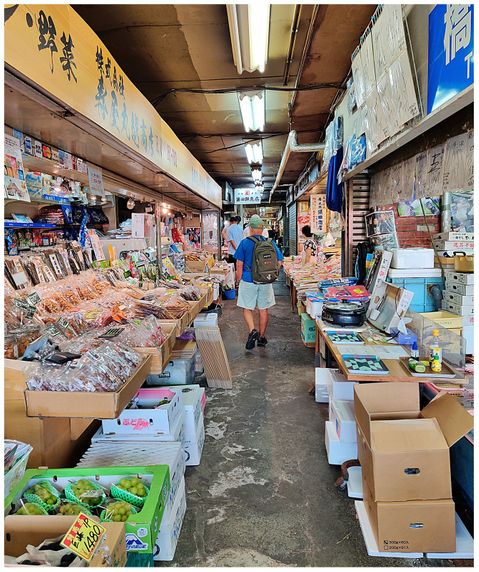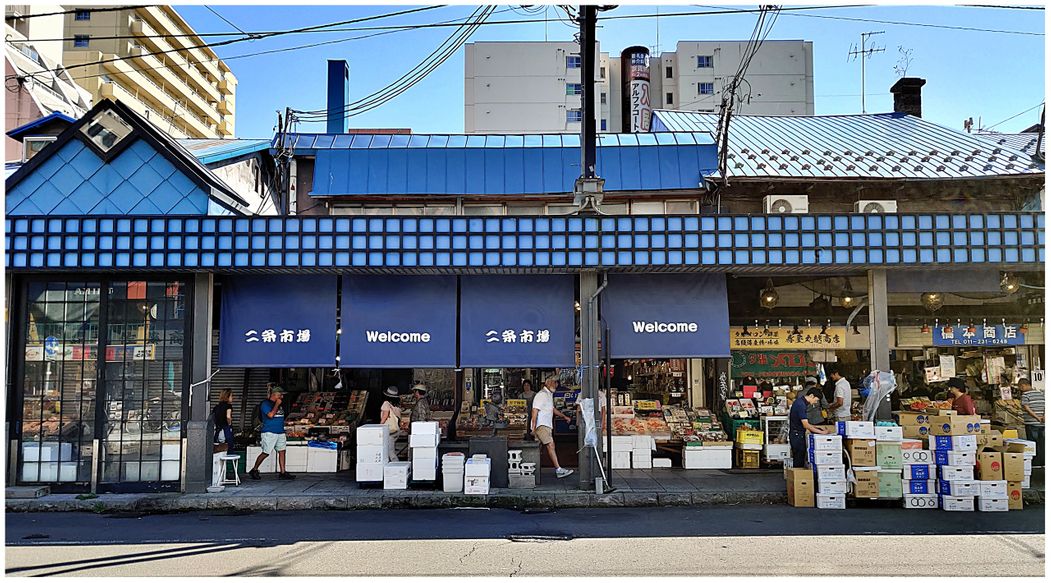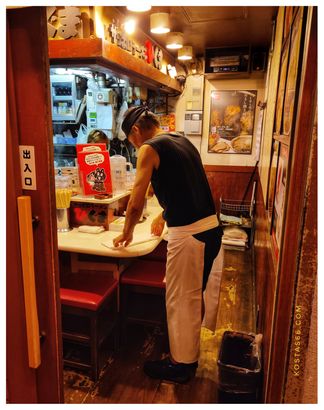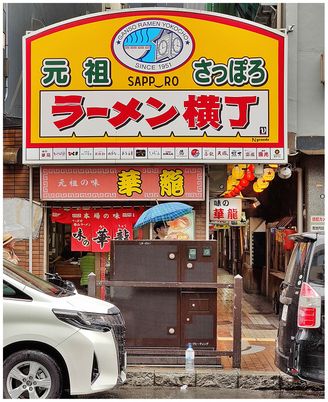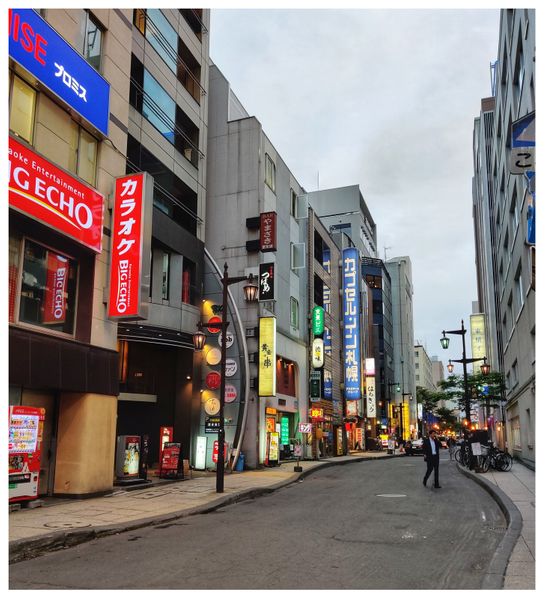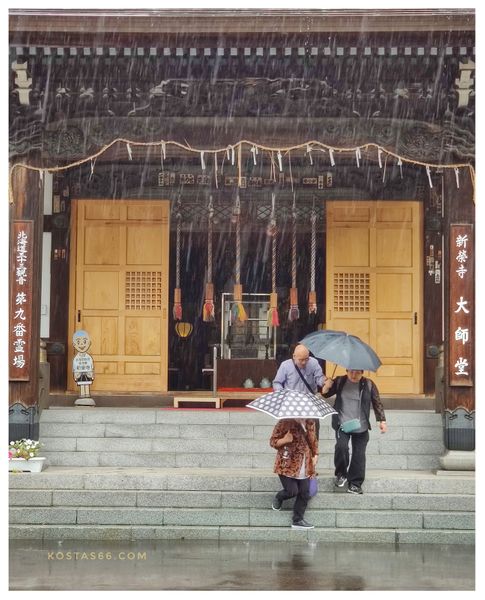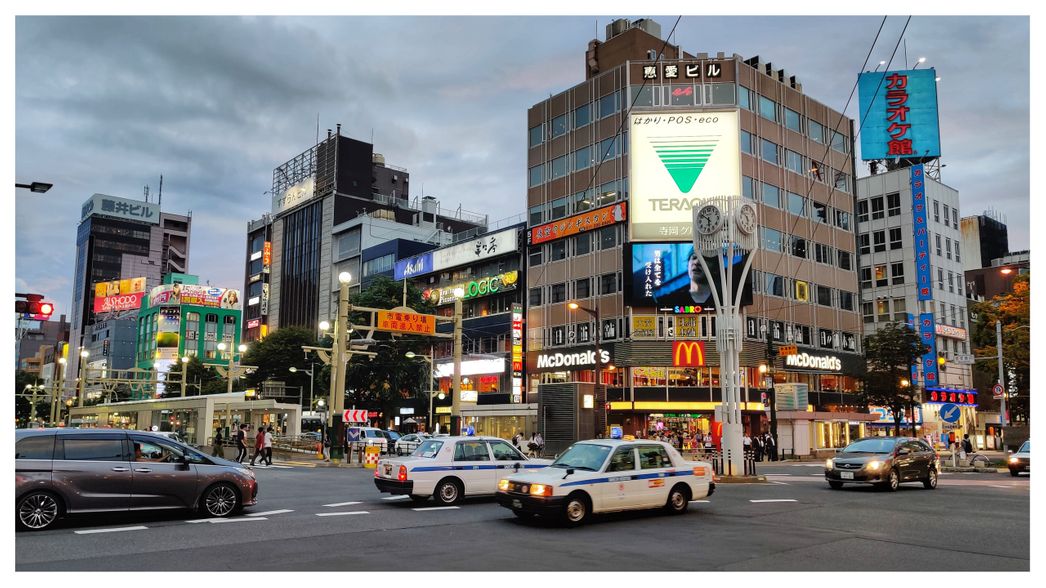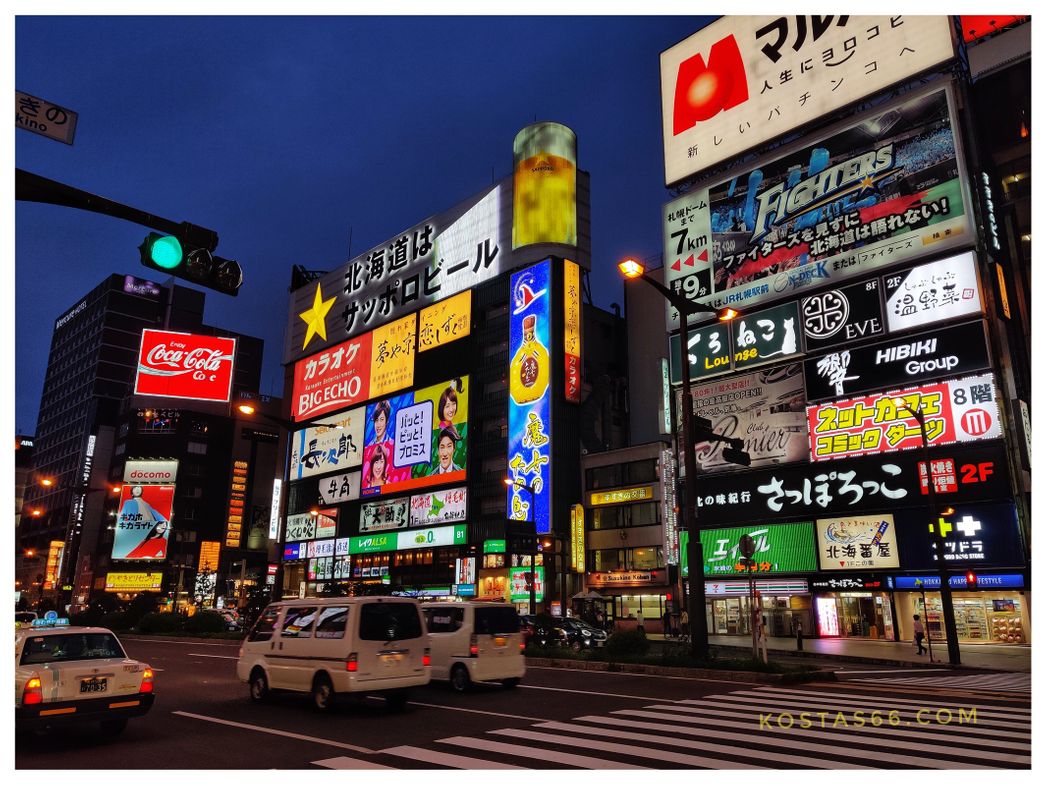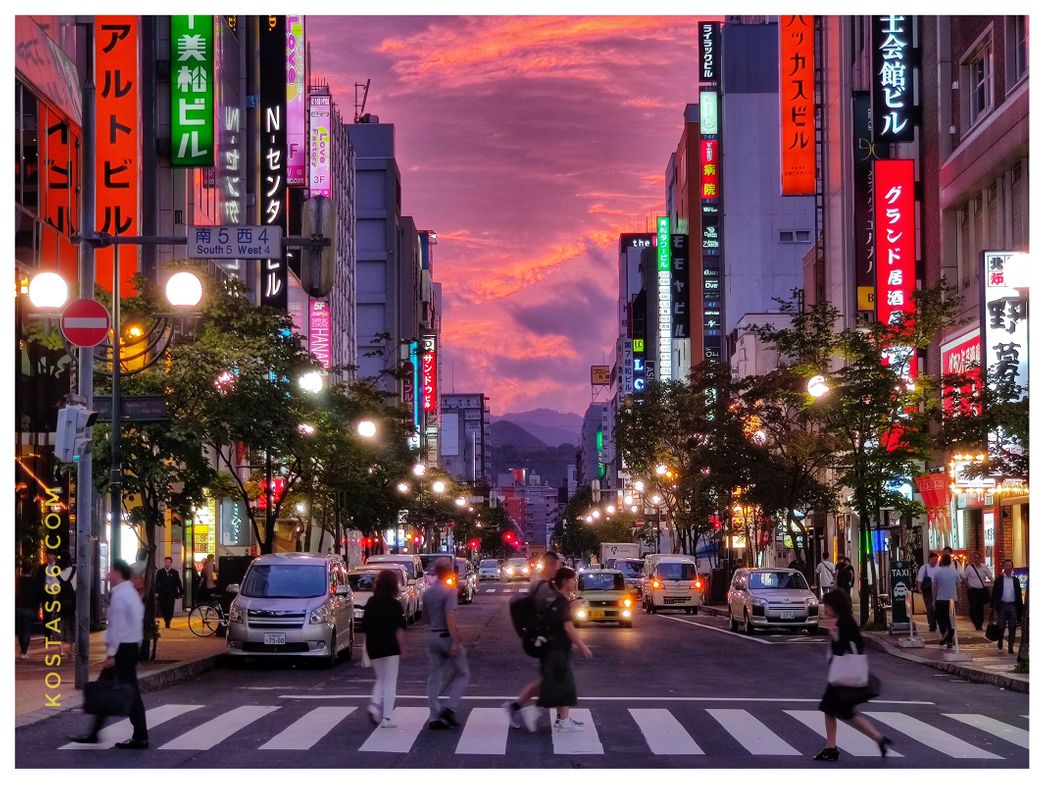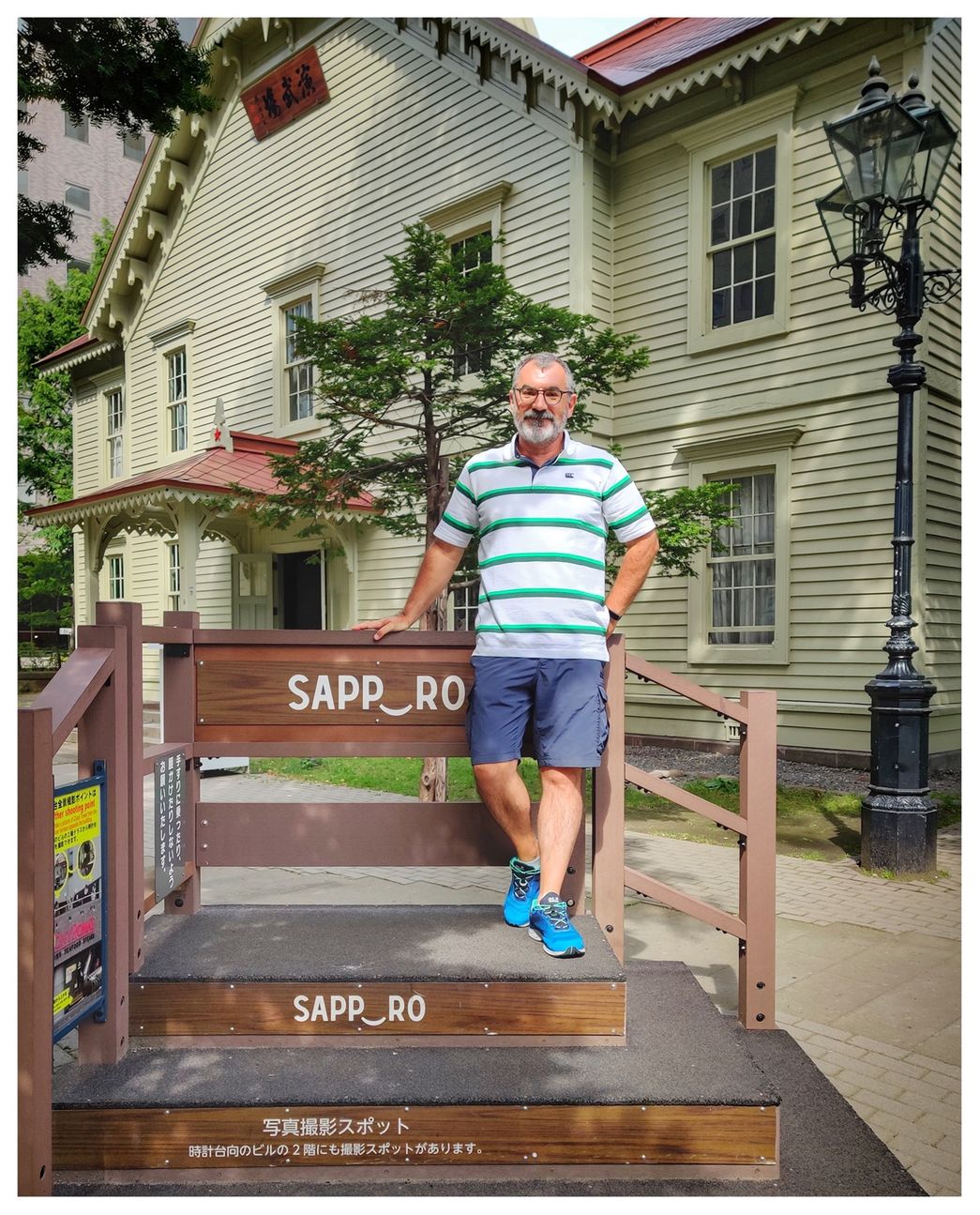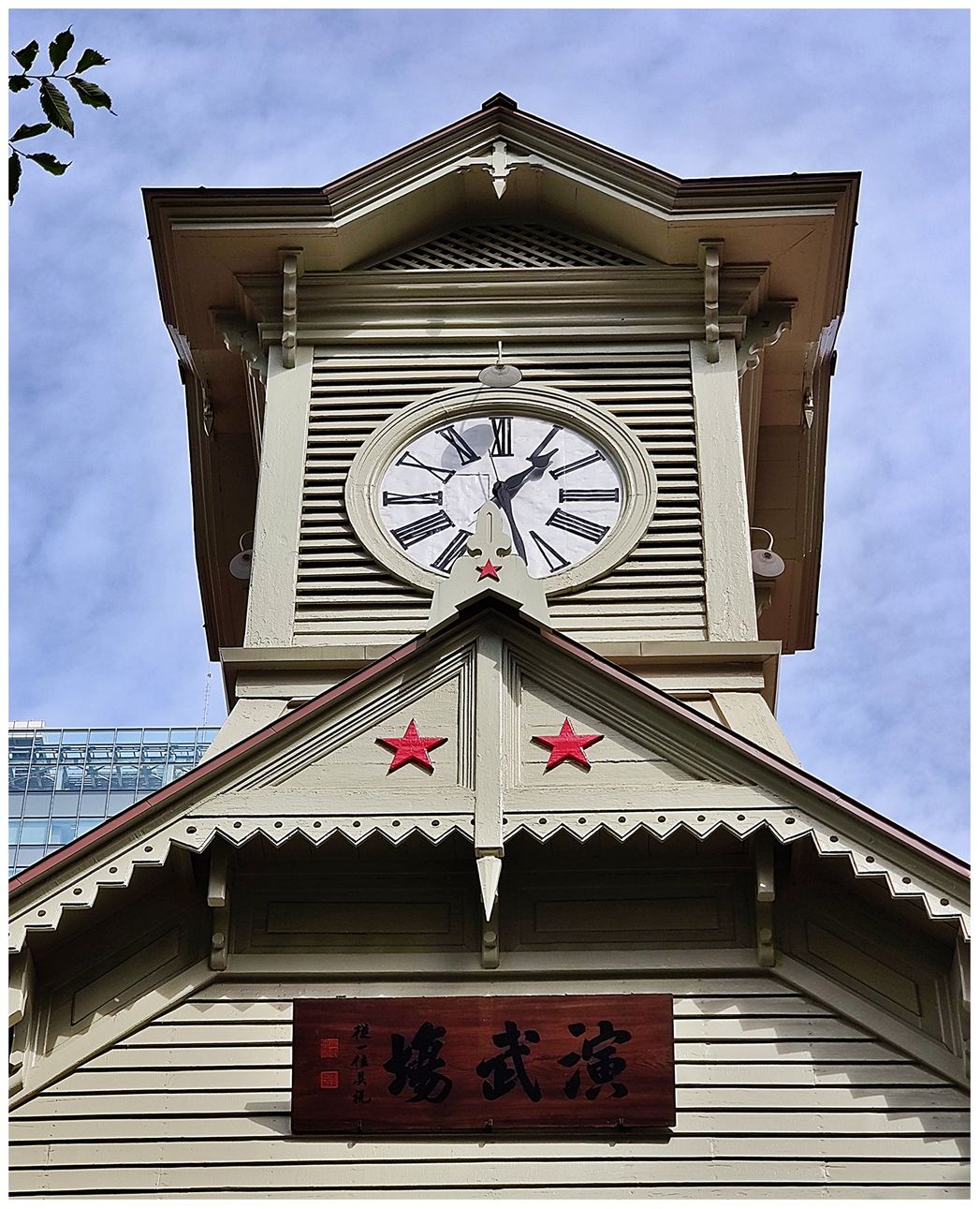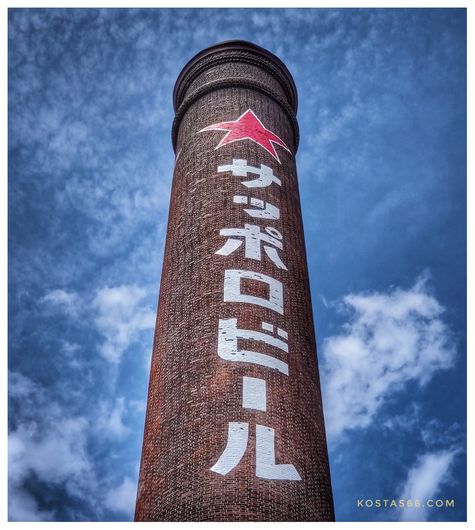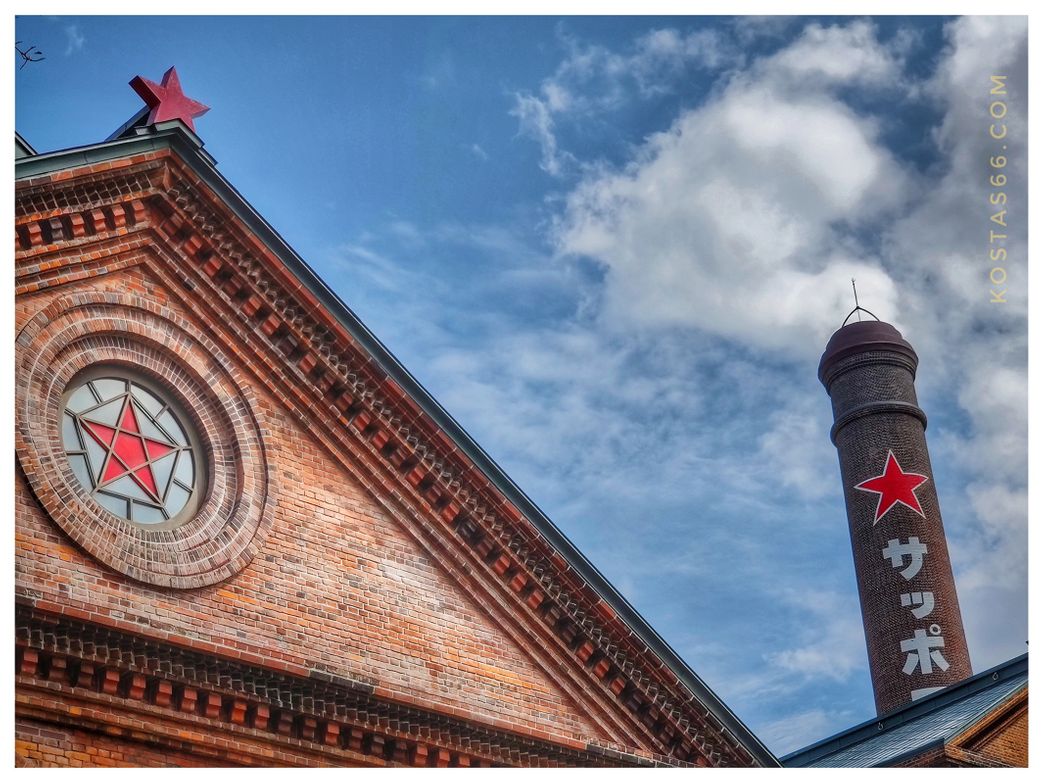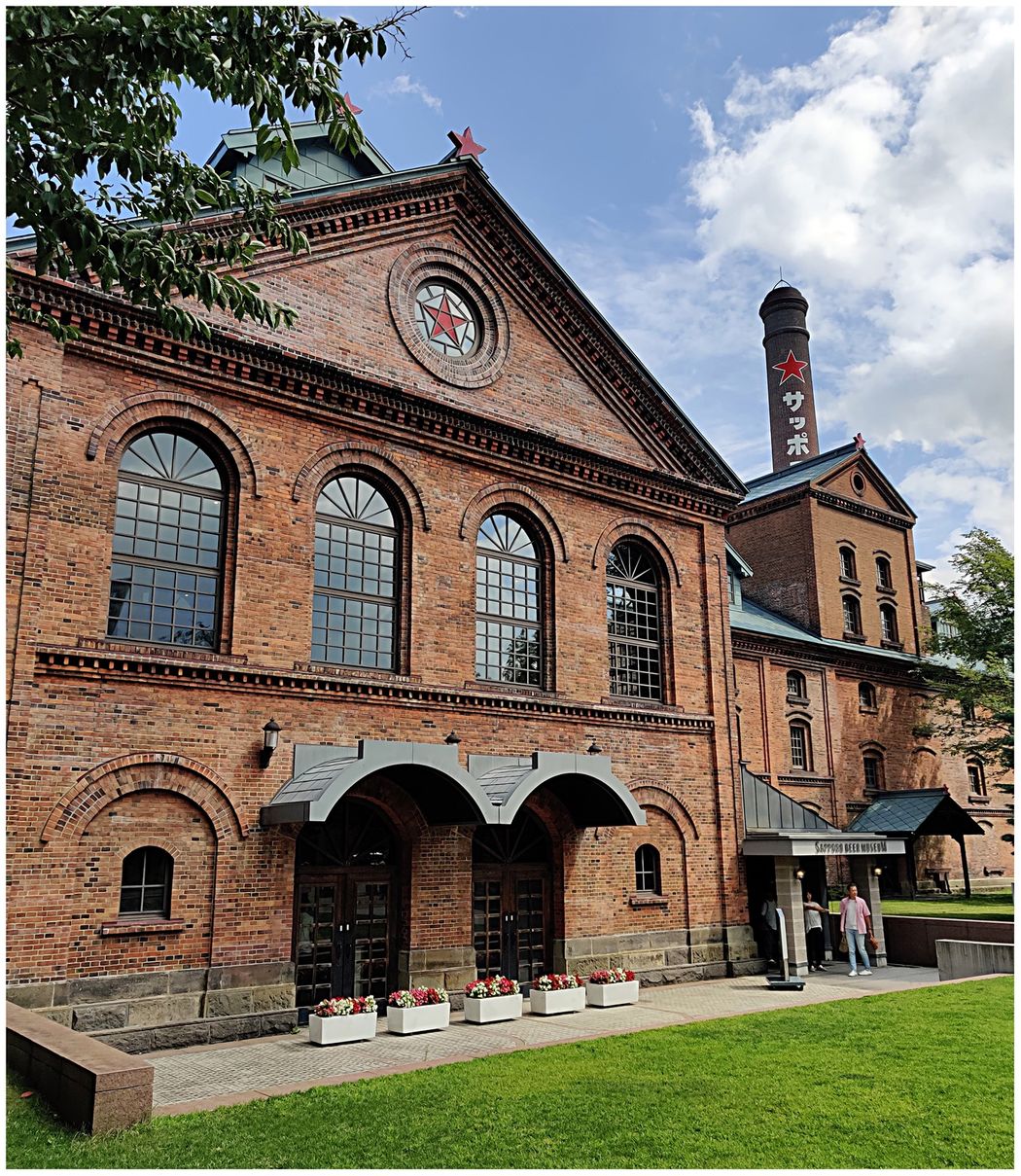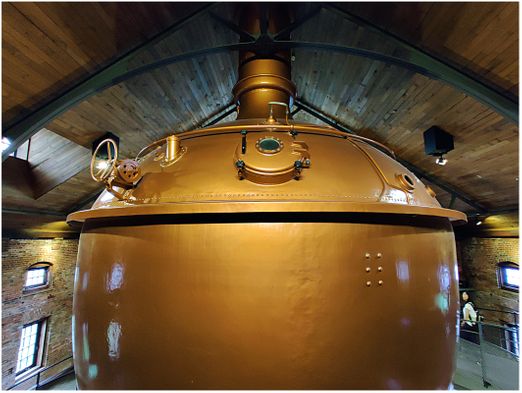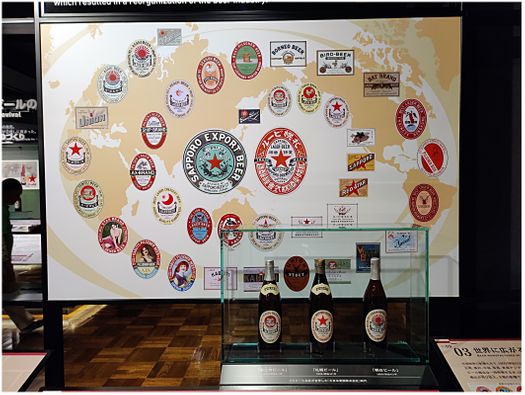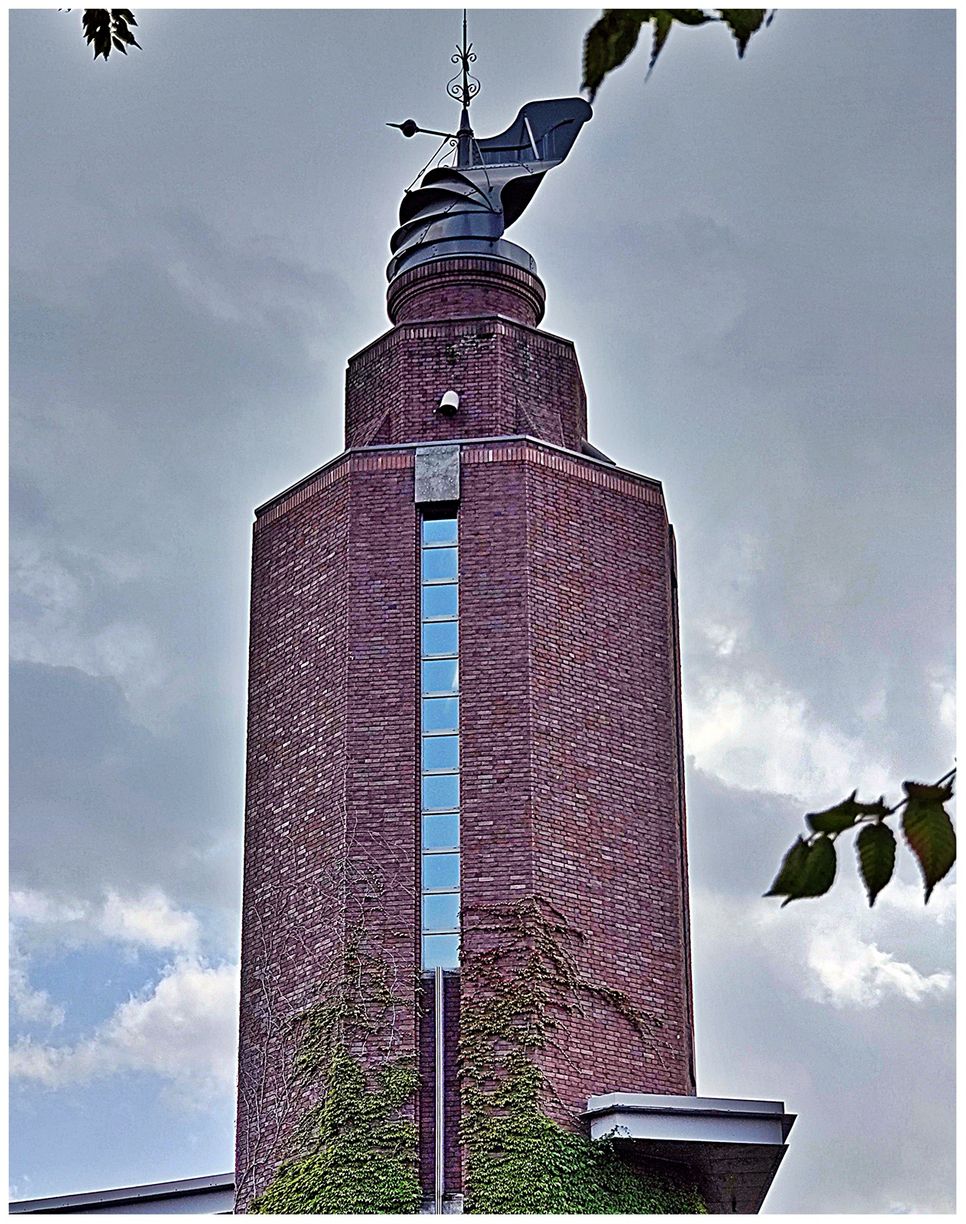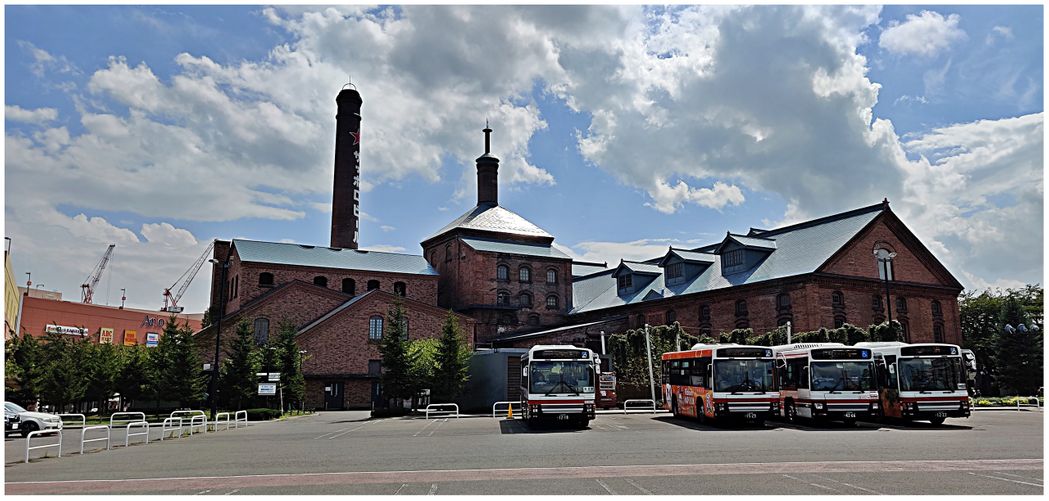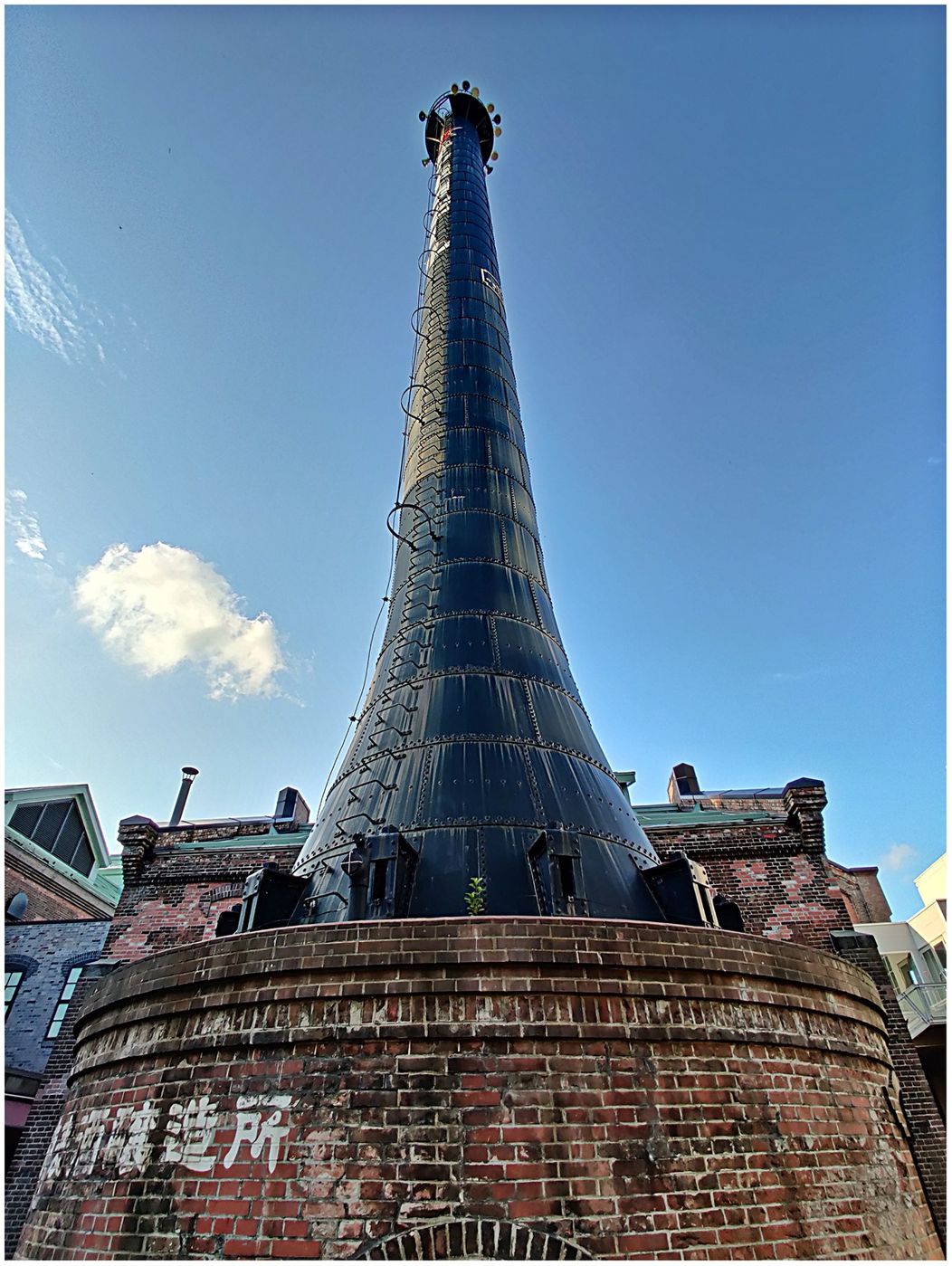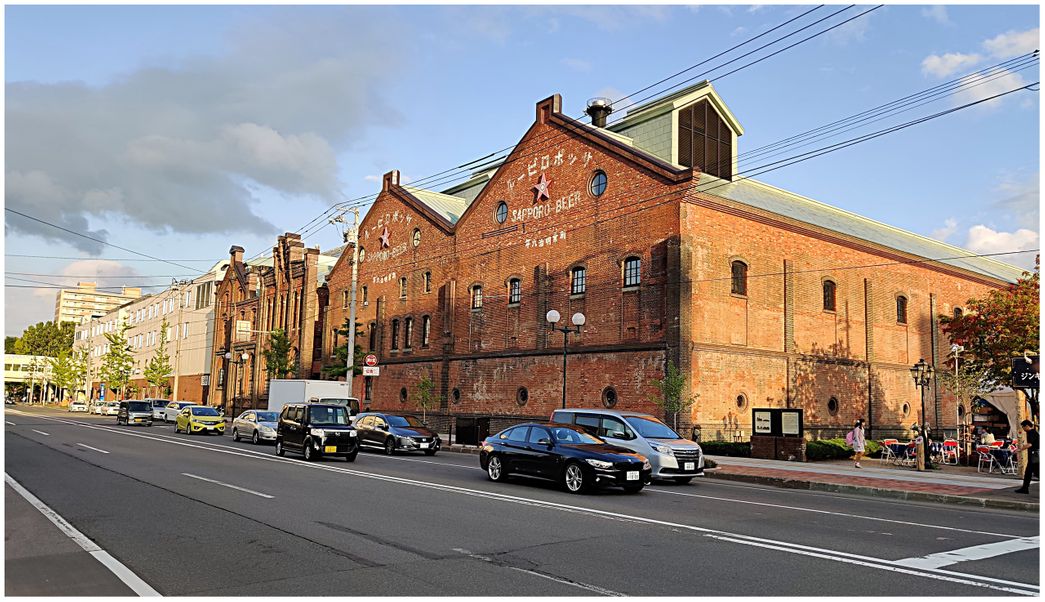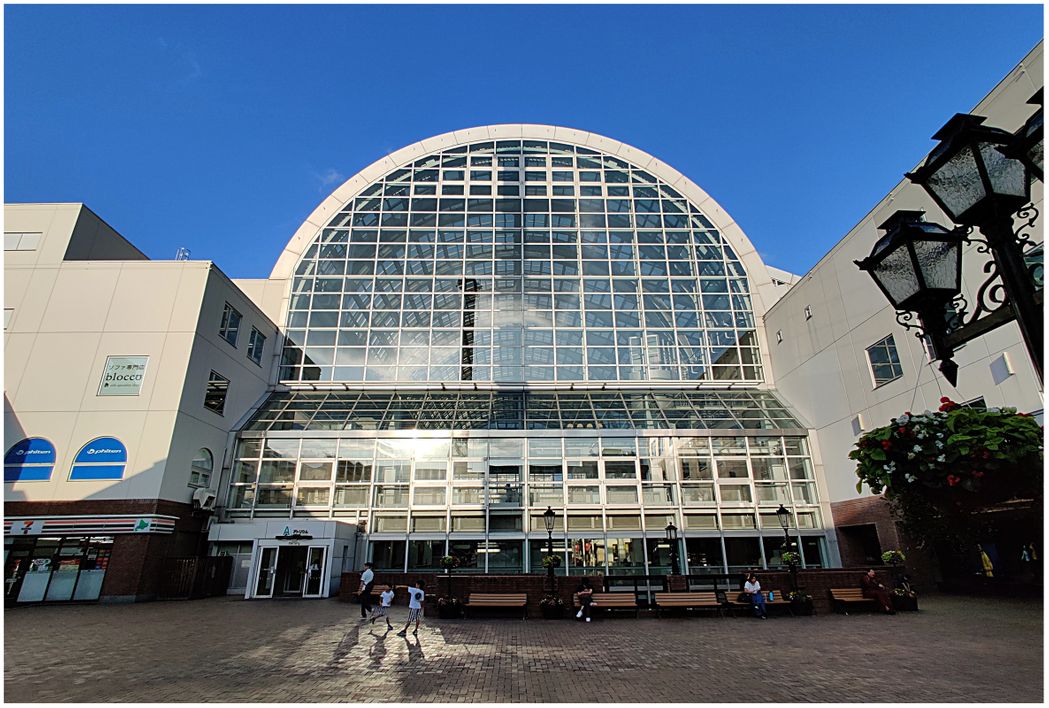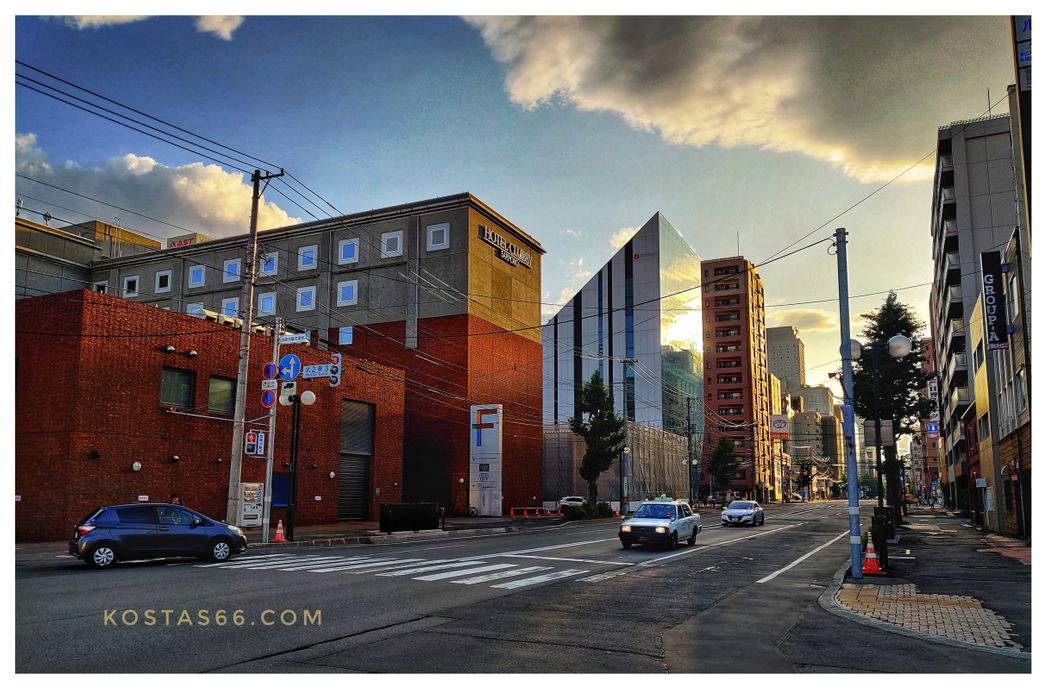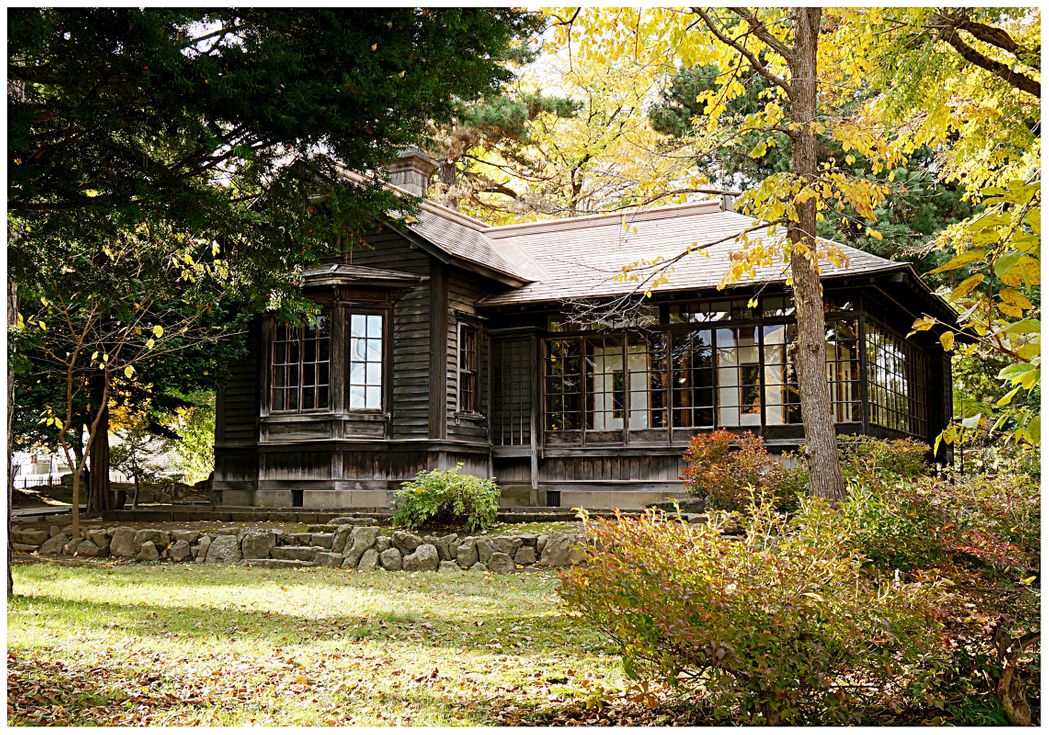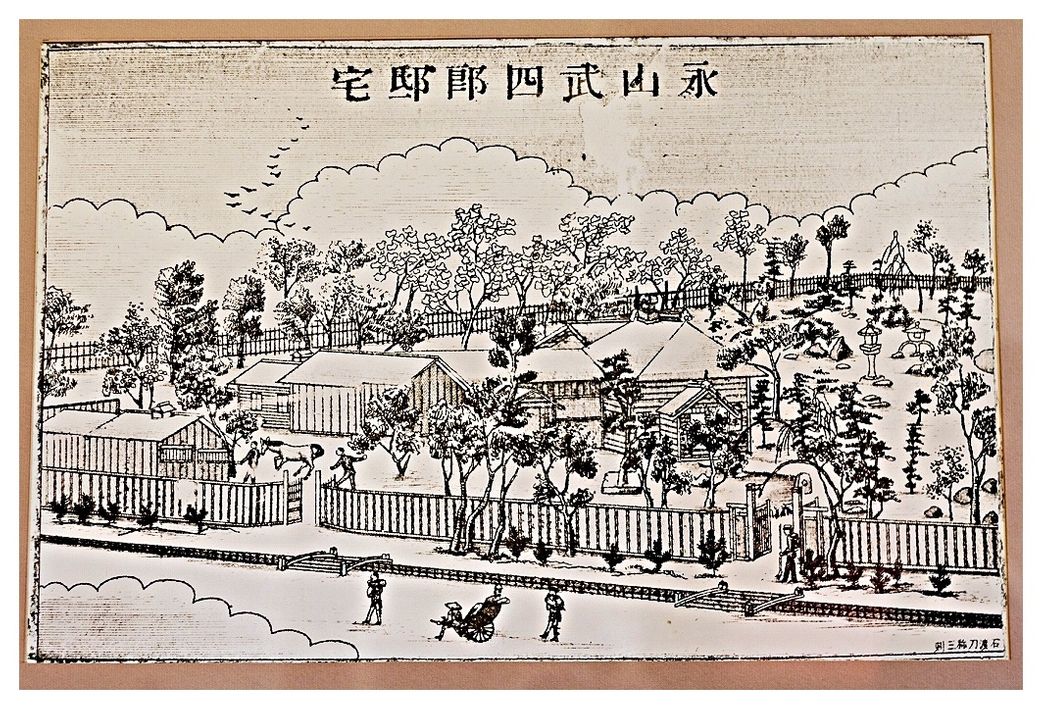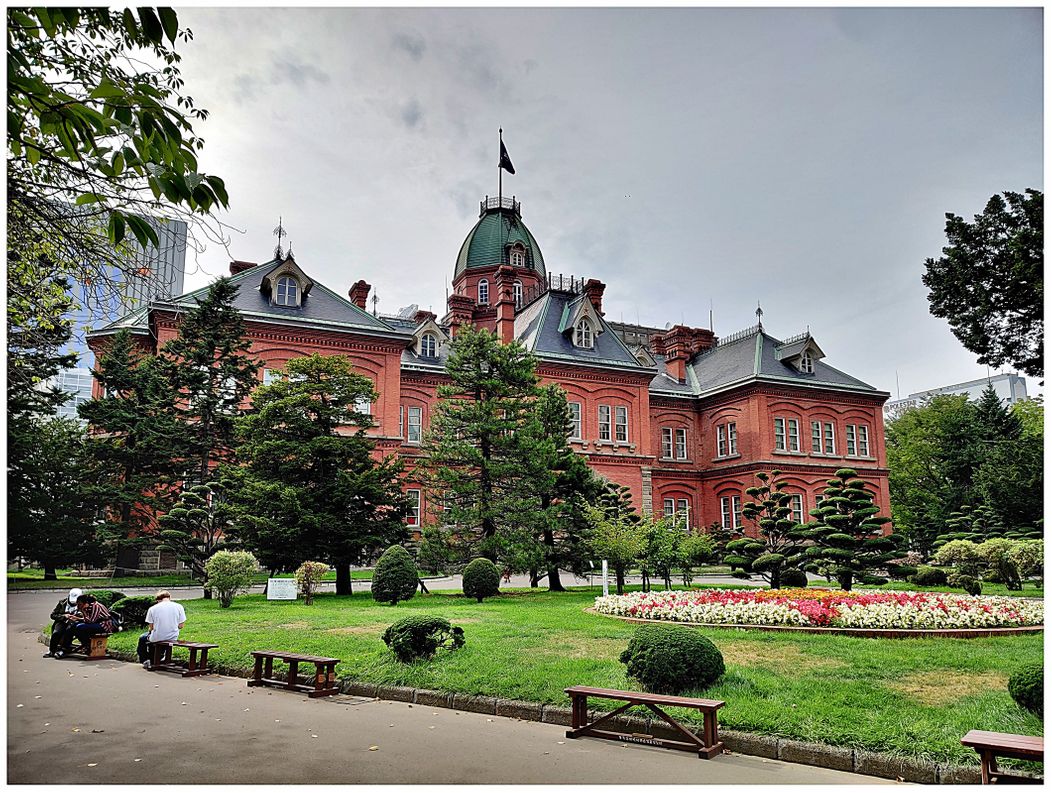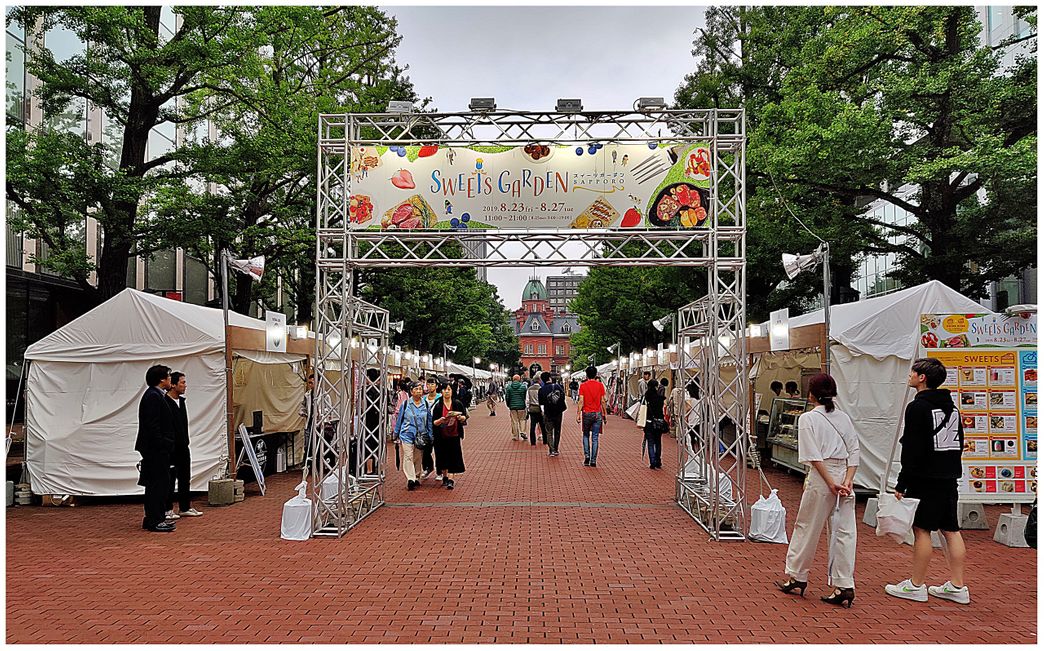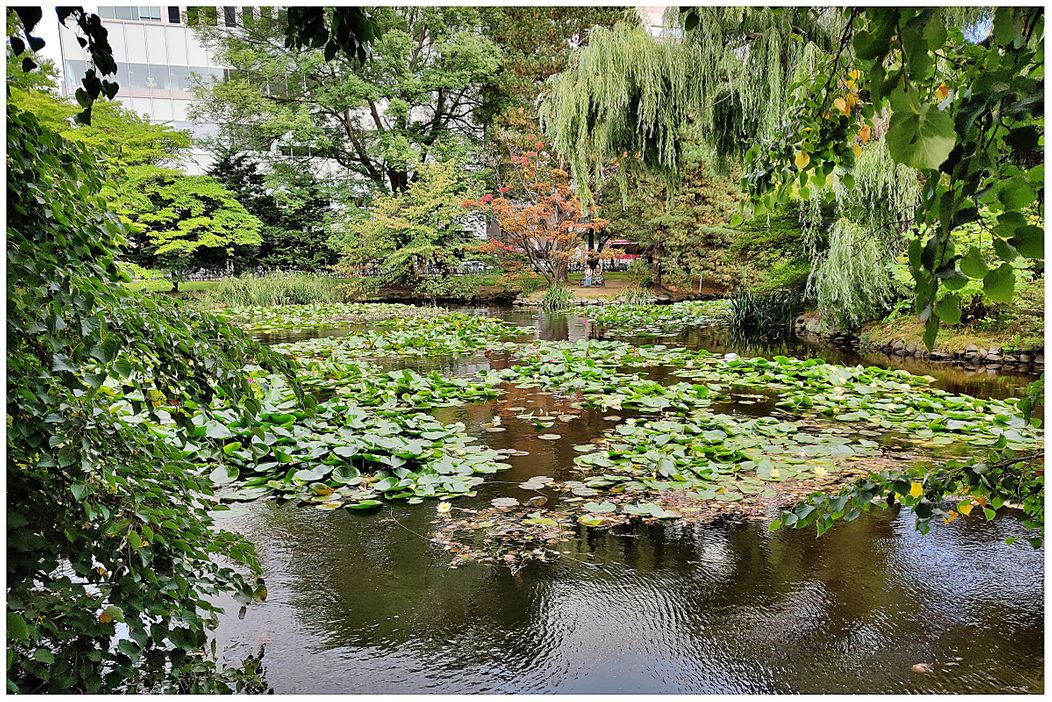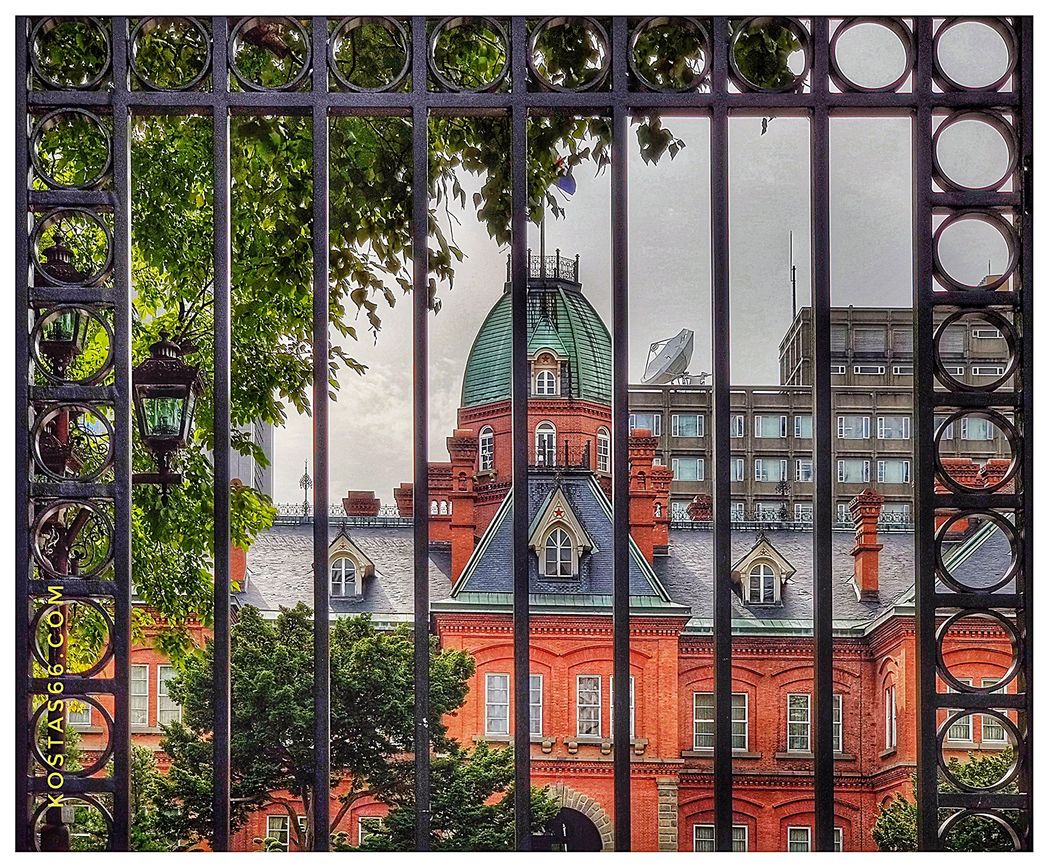SAPPORO
downtown (Part I)
August/September 2019
Sapporo, known mainly for its annual Sapporo Snow Festival and the sculptures made of ice, is the capital city of Hokkaido. Built at the edge of Ishikari Plain, a vast expanse of flat, well-drained land relatively uncommon in the otherwise mountainous geography of Hokkaido, the area was home to several indigenous Ainu settlements. The plain helped the city planners closely follow a grid plan with streets at right angles to form city blocks.
Toyohira River in the sunset.
In 1866, at the end of the Edo period, construction began on a canal through the area, encouraging several early settlers to establish Sapporo village. The settlement's name was taken from the Ainu language, "sat poro pet", and can be translated as "dry, great river", which denotes the Toyohira River, which runs through the southeastern part of the city. 1868 is the officially recognized year celebrated as the "birth" of Sapporo.
The Meiji government on1870 approached the American Government for assistance in developing the land and modernizing agricultural techniques.
The American consultants who arrived on the island established sheep and cattle ranches and the Sapporo Agricultural College to train students on modern farming techniques. This resulted in today's excellent farming and agricultural products of Hokkaido.
Suppose one American has associated his name with the early days of Sapporo. In that case, this is undoubtedly William S. Clark, who was the president of the Massachusetts Agricultural College and who came to be the founding vice-president of the Sapporo Agricultural College for only eight months from 1876 to 1877. His statue on Observation Hill has become one of the city's symbols, and his face can be seen everywhere on the island.
William S. Clark statue at Observation Hill in Sapporo.
Sapporo is a new city unlike the other “old” Japanese cities, which feature centuries-old castles, palaces, shrines, and temples. There are no known worldwide attractions here, but the city is agreeable and enjoyable to explore and walk around. Besides, Sapporo is used by many visitors as the base to explore the southern part of Hokkaido. Most visitors come here during winter, as Sapporo receives more snowfall than any other big city worldwide. But, a visit during summer gives you more freedom to enjoy the city and the nature around it.
Sapporo sewer cover depicts the Sapporo Clock Tower and a pair of salmon.
Red Star
The Hokkaido Development Commission was established in 1869 and used a red star on the "Hokushinki", its flag. When visiting historical buildings, search for the Red Star, the symbol of the Hokkaido Development Commission. The Star, which decorates the cans and bottles of Sapporo beer, symbolizes the polar Star, which the Hokkaido Development Commission used. This Star was also used on buildings built by the Commission. Visitors can search for the red Star when visiting several Sapporo historical buildings and sites, like the Sapporo Clock Tower and the Former Hokkaido Government Office Building.
I split my Sapporo tour into two chapters. The first chapter named "Downtown" follows right away. For the second chapter named "At the edge of the city..." follow the link.
Downtown
Downtown Sapporo.
Hokkaido Shrine
On the city's western edge, where the mountains start, stands probably the most exciting tourist attraction of Sapporo, the Hokkaido Shrine. The shrine is in Maruyama Park, next to the Sapporo City Maruyama Zoo. The Hokkaido Shrine enshrines four kami (Shinto deities: spirits, phenomena, or "holy powers"), including the soul of Emperor Meiji. Several early explorers of Hokkaidō, such as Mamiya Rinzō, are also enshrined here.
Hokkaido Shrine (the entrance).
In 1869, a ceremony to enshrine three kami was held in Tokyo by order of Emperor Meiji. They were enshrined as the three deities of the Hokkaido reclamation, and they were later moved to Sapporo. An interim shrine building for the three kami was constructed in 1870 in Sapporo, although its location was different from the current point where the Hokkaido Shrine stands. In 1871, a shrine was erected to the current place and named the "Sapporo Shrine" (Sapporo Jinja), and on September 14, an inaugural ceremony was held. The soul of Emperor Meiji was enshrined only in 1964, and the building was officially renamed "Hokkaido Shrine". The building was destroyed by a fire in 1974 and restored in 1978.
Hokkaido Shrine (the main courtyard).
The shrine is beautiful and tidy, but if you have visited old shrines in other parts of japan, this one looks a bit too shiny-new!
There are a couple of souvenir and snack/coffee shops in the park outside the shrine but do not bother. At the northeastern end of the park, just meters away from the main entrance to the shrine area, there is a lovely Starbucks café. If you are looking for something more traditional, head to Morihico Coffee, one of the most famous coffee houses in the city. It is a couple of square blocks from the eastern park limits.
The main Temple of the Hokkaido Shrine.
The gate to the Hokkaido Shrine (courtyard side).
Note: There is a parking lot outside the shrine area. By entering, you are given a parking ticket, which you must stamp at the security office just after entering the main gate to the shrine (on your left). Forget to stamp it, and you get a substantial monetary penalty. You can exit the parking lot without paying a single yen by stamping the ticket.
The purifying well outside the Hokkaido Shrine.
The main courtyard of the Hokkaido Shrine.
"Kazaridaru" (Sake barrels).
The main Temple of the Hokkaido Shrine (at the background).
From June 14 to 16 every year, the Main festival of Hokkaido Shrine, also called "Sapporo Festival" (Sapporo Matsuri), is held, and people bearing Mikoshi parades line down the street, which leads to the shrine. During the season when cherry trees bloom in the area, the shrine is crowded with people enjoying Hanami. Many people also visit the shrine during the Japanese New Year to go to Hatsumōde.
Hokkaido Shrine (the big Torri and the souvenir shop/cafe by the parking).
Odori Park
Odori Park is a 1.5 km-long park in the heart of Sapporo, roughly dividing the city into north and south sections. During the urban planning of Sapporo, it was initially designated as the city's Main Street, but it eventually became a park; so, it is no surprise that Odori means "large street" in Japanese. Throughout the year, many events and ceremonies, such as the Sapporo Lilac Festival and the Sapporo Snow Festival, are held in the park, and local landmarks, including the Sapporo TV Tower and the Sapporo City Archive Museum, are located within its boundaries.
Odori today is covered with flower gardens, fountains, small squares, sculptures, and resting and sitting areas for the people doing their shopping. The most significant landmark of Sapporo and one of the city's best-known tourist attractions are located at the very eastern end of the park: the iconic Sapporo TV Tower.
Odori Park seen from the observation deck of Sapporo TV Tower.
Odori Park.
Sapporo TV Tower
Completed in 1956, Sapporo TV Tower is located at the eastern edge of Odori Park and offers a 360° view of Sapporo. It has been a Sapporo landmark and witnessed the city's development for over half a century. From the observation deck, approximately 90 meters above ground, visitors can enjoy beautiful seasonal views of Odori Park and various events in the park. The observation deck is the best place to see the snow festival and the park's illuminated decorations in the winter. When the sky is clear, one can see as far as Ishikari Plain and the Sea of Japan.
The admission fee for the Observation deck is ¥720. There is a souvenir shop at the Observation deck and several restaurants at its base. Among them, there is a Sapporo beer garden.
One of Odori Park sculptures.
Sapporo TV Tower.
Sapporo TV Tower by night.
Sosei River and Nijo Market (the building on the left bank with the blue roof) as seen from the observation deck of Sapporo TV Tower.
View from the observation deck of Sapporo TV Tower towards Mount Moiwa. Odori park can be seen on the right of the picture.
Views from the observation deck of Sapporo TV Tower towards Mount Moiwa.
Sapporo beer garden at the base of TV Tower.
Underground shopping malls
Do not forget that Sapporo receives more snowfall than any other major city on Earth. Like several other cities which face cold and snow problems during winter, Sapporo has developed several underground shopping malls.
Underground shopping malls in downtown Sapporo.
Sapporo Ekimae-dori connects Sapporo Station (the central train station) with Susukino, the busiest neighborhood in downtown Sapporo. Sapporo Ekimae-Dori, the city's most central and commercial street, intersects vertically with Odori park, not far away from Sapporo TV Tower. Under Sapporo Ekimae-Dori, there is a 520m-long underground walkway (Chi-Ka-Ho). It takes about 10 minutes to walk through. In the "resting space" on each side, there are tables and chairs for you to relax, and there is also a free Wi-Fi service. The "resting space" and "intersection squares" are alive with tourism promotions for various areas in Hokkaido, sales of specialty products and miscellaneous goods, and events such as exhibitions of artistic works.
The place is rather depressing, with low ceilings, and is of no interest except for a couple of intersections.
Rugby World Cup 2019 advertised at Chi-Ka-Ho.
Chi-Ka-Ho connects some major underground shopping malls: The Sapporo Station Mall and the Aurora Town & Pole Town malls, which both originate at the Odori Station at the intersection of the Namboku and Tozai Lines. “Aurora Town” extends to the east, and “Pole Town” extends to the south. Aurora Town is 312m long and includes the “Aurora Plaza“event space and an open space called “Aurora Square”. Aurora Town is a spacious area that puts visitors at ease. From the end of Aurora mall at the east starts a long underground passage connecting it to the Bus Center Mae Station and further. The multi-vision video projector HILOSHI, located in “Pole Square” in front of the ticket gate of Odori Station, is a popular meeting place for young people. It is from this point that the 400m-long Pole Town begins ending at the Susukino Station on the Namboku Line. The underground shopping area hosts several shops and restaurants, and it is completed with some smaller passages which connect big stores and other points of interest.
The “city under the city” is crowded in winter, but I do not see a reason to go down there when the weather is good.
Underground shopping mall in Sapporo.
The central Tourist Information Center at the Sapporo Station shopping Mall.
Sapporo (train) Station.
Around the Sapporo Station there are some of the best shops in the city. I recommend two of them:
a) the Sapporo branch of Kinokuniya bookstores, which is probably the most up-to-date bookstore in the city. The bookstore is located opposite the western part of the Sapporo Station complex, overlooking another iconic Japanese store, the Daimaru Sapporo. The Starbucks inside has lots of light coming from the floor-to-ceiling wall-to-wall windows; thus, it is the perfect spot to drink your coffee while reading a book.
b) Daimaru Sapporo is, the local branch of the famous Japanese Department store chain. You can spend a whole day here shopping, but you must visit the underground level where the food store is located: lots of food, groceries, seafood, cakes, and desserts...to take away or even eat on the spot.
Daimaru Sapporo.
Tanukikoji Shopping Street
Every major Japanese city has a covered shopping street so that people can shop without worrying about the weather. Sapporo has Tanukikoji (aka Long Arcade), one of the oldest shopping streets in Hokkaido (established in 1873). Tanuki comes from “raccoon dog” in Japanese, and Koji means narrow street. This covered street is parallel to Odori park, some 5 blocks to the south. It starts at Sosei River on the east (just opposite the Nijo Fish Market) and finishes 7 blocks (chome) away to the west. This historic 900m-long covered shopping arcade features over 200 shops, including restaurants, hotels, cafes, Karaoke, night bars, and several pachinkos (*)!
(*) Pachinko parlors look like nightclubs from the outside, but the leading entertainment here are the many rows of machines emitting sounds similar to jackpot machines... yet are unique to Japan. Gambling is illegal in Japan, and to circumvent that, pachinko was created. Technically speaking, you play for little metal balls and not the money. The metal balls can be changed to money at another business operated separately from the pachinko parlor.
Kinokuniya bookstore.
The mascot of Tanukikoji Shopping Street.
Tanukikoji Shopping Street.
Tanukikoji Shopping Street.
The eastern part has more upscale shops, but the western half has a more significant interest because it houses more traditional shops. The last block (7-chome) to the west is the most rundown, and it feels like you have gone back in time to the 70s and 80s. It houses, among others, a secondhand cloth store, a specialist tea shop/tea rooms, a vintage and secondhand records music shop, and a couple of nice restaurants.
The “Honjin Tanuki Daimyo” shrine.
The area around the last block and further west have low buildings and several old wooden ones. Visitors will find beautiful old cafes, jeans shops, wine bars, and small restaurants in these buildings. I recommend visiting the “Flamingo” jeans shop, which offers many old American-style casual wear, including Japanese denim brands such as Momotaro and Fullcount.
The last block (7-chome) of the Tanukikoji Shopping Street is the most rundown and it feels like going back in time to the 70s and 80s.
At 5-chome, there is a Kit Kat specialty shop with many flavors that can only be found in Japan and nowhere else! Opposite the Kit Kat shop, there is a shrine. “Honjin Tanuki Daimyo” shrine was erected (in 1973) on the 100th anniversary of Tanukikoji. Here people pray to the god of business, as portrayed by a Tanuki (raccoon dog). On the same block is located a pet shop (I always feel unfortunate and depressed to watch all these little animals with sad eyes looking at you, begging for some love) and an exciting tourist information center. They provide information from accommodation to car & bike rental; meal coupons; baggage storage; money exchange; Japanese cultural experiences like wearing kimonos and DIY traditional fans, etc. They also sell luggage and a few traditional products, such as handkerchiefs and chopsticks, to bring back home as a souvenir.
Shops of Tanukikoji Shopping Street. Second hand vinyl shop.
Shops in and around Tanukikoji Shopping Street.
Hokkaido University
The main gate of Hokkaido University is a 7-minute walk north of Sapporo Station. The walking course around the university, which is widely open to the public, is about 6 kilometers long and can be walked leisurely. The buildings from the Sapporo Agricultural College era, built in the Meiji Era, are used even today as school buildings.
The old buildings of Hokkaido University.
Hokkaido University first opened as Sapporo Agricultural College in 1876. Its historical buildings and elm and ginkgo trees draw many tourists. I recommend getting a campus map here before walking through the campus. The Hokkaido University Museum (Sapporo’s first reinforced concrete building, opened in 1929), which is unrestricted, is not to be missed. Here, one can see exhibits of scientific samples such as nipponosaurus and specimens of cattle skeletal structure. Opposite the Museum building, there is a convenience store with sitting area upstairs to enjoy your coffee or snacks.
The museum at Hokkaido University.
You can download a printable leaflet with information and map from this link: Information leaflet.
The bust of William Clark at the gardens of Hokkaido University.
Water lilies at the premises of Hokkaido University.
Nijo Market
The seas of northern Japan are rich with fish and crustaceans that have been part of the food culture of Hokkaido for centuries. For that reason, Sapporo has a reputation in Japan for being a prominent gourmet spot for seafood. Nijo Market (Nijō Ichiba) is mainly a fish market, which occupies about one city block on the east bank of the Sosei River, two blocks south of Sapporo TV Tower.
Nijo Market.
Nijo Market developed in the early Meiji Period when fishermen from Ishikari Bay started selling fresh fish there. Initially, it was just a row of fishermen's stalls along the Sosei river banks. Still, eventually, noodle shops, bars, and greengrocers opened, laying the foundations for today's Nijo Market. Over a century later, the market continues to serve residents' culinary needs. It is a place for gourmands to shop for fresh local produce and seafood such as crabs, salmon eggs, sea urchins, and various fresh and prepared fish. Due partly to its central location, the market is popular among tourists searching for Hokkaido delicacies such as crabs and scallops.
Nijo Market.
Nijo Market.
Nijo Market.
Nijo Market street food.
The market is open from around 7:00 to 18:00 on all days of the week, with individual shops maintaining their opening and closing hours. Several restaurants can be found among the shops, including a collection of small drinking places and restaurants along a narrow corridor called Noren Yokocho. Still, the best way to enjoy the market is to do what Japanese people call "tabearuki", which means to buy small portions of whatever tickles your desire while strolling through the area. You can try so many regional specialties grilled right before your eyes.
Nijo Market.
Nijo Market.
Susukino
Susukino is Japan's most extensive entertainment district north of Tokyo, or at least this is what locals say. It has stores, bars, restaurants, karaoke shops, pachinko parlors, and red-light establishments. The Ganso Ramen Yokocho (Original Ramen Alley), a narrow lane lined with little shops serving Sapporo's famous miso ramen soup, is of particular interest to noodle lovers.
Ganso Ramen Yokocho in Susukino.
A restaurant in Ganso Ramen Yokocho.
The entrance to Ganso Ramen Yokocho (Ramen Alley).
Susukino is a rough area with uncertain borders. In tourist guides, it is usually defined as the area between the roadways of Minami 4 and Minami 6 to the north and south and from Nishi 2 chome to Nishi 6 chome to the east and west.
Typical Susukino street.
Buddhist temple in Susukino
The Settlement Envoyship pioneering Hokkaido decided to build a red-light area to keep laborers in pioneering in Sapporo engaged. Susukino originated back in 1871 as Sapporo’s red-light district. The area went through changes, depending on prostitution enacting laws in Japan. At some time, the red-light district moved to another part of the city, and Susukino was not an Akasen (red-line) district anymore, an area where prostitution was acknowledged by the government but was an Aosen (blue-line) district, where a lot of restaurants and bars illegally promoted prostitution. In the 1980s, many hotels were constructed around the Susukino district, and famous cabarets appeared.
Susukino.
Susukino by night.
Today, Susukino is an area crowded by tourists and locals, famous mainly for its bars, restaurants, and neon lights.
Sunset at Susukino.
Sapporo Clock Tower
The Clock Tower (Tokeidai) is one of the city’s symbols, pictured in every book or site about Hokkaido. It is located just north of Odori park, a block from the TV Tower. The wooden building is of American design and is one of the few surviving Western-style buildings in Sapporo, a city developed in the 1870s with assistance from the American government.
Sapporo Clock Tower.
The tower was built in 1878 and is all that remains of the drill hall of the former Sapporo Agricultural College (now Hokkaido University). The building was one of the earliest to be built in Sapporo, as the city itself was chosen as the administrative center of Hokkaido in 1868, the date currently recognized as the official birth of the city. In 1881, a clock was purchased from Boston and installed on it, which continues to run and keep time, and the chimes can be heard every hour.
Taking a photo at Sapporo Clock Tower is a must.
This is the oldest building in Sapporo, and it serves as a museum with displays about the building's history and Sapporo on the first floor. On the second floor are displays about the clock and a spacious ceremony hall that calls to mind the simple buildings of the colonial American Midwest. The hall can be rented for private functions and occasionally for concerts.
A closeup of the clock of the Sapporo Clock Tower.
The Sapporo Beer Museum (Sapporo Biru Hakubutsukan) is a brick building set in a green area with the Sapporo Beer Garden and another big "Bavarian-style" restaurant. The complex is some blocks east of Sapporo Station, and the parking is free. A Shopping mall is located at the back of the complex.
The Sapporo Beer Museum was originally built in 1890 as a sugar factory and owed much to the ideas of William Clark, a former President of Massachusetts Agricultural College, who became a Vice-president of Sapporo Agricultural College.
Sapporo Beer Museum/ Sapporo Factory
The Sapporo Beer Museum.
The first beer production in Japan began on the site of the present Sapporo Beer Factory in 1877 based on German beer-making techniques brought back to Japan by Nakagawa Seibei, who teamed up with Murahashi Hisanari to establish the Sapporo Beer Company. The site of the original sugar factory, now the Sapporo Beer Museum, was purchased by the Sapporo Beer Company in 1903.
Sapporo beer production continued on the site until 1965, and the Sapporo Beer Museum opened in the renovated building in 1987, with the further renovation and a re-opening in 2004.
The entrance to the Sapporo Beer Museum.
Now the three-story brick building is a modern museum dedicated to the history of beer brewing with exhibits explaining the process of making beer, including a large copper kettle, the ingredients needed for beer-making, as well as the history of Sapporo beer in Japan from its first beer hall in the Ginza area of Tokyo to its present status as one of the big four breweries in Japan along with Kirin, Asahi, and Suntory.
The Sapporo Beer Museum has an exciting focus on the design of Sapporo beer bottles over the years and Sapporo beer posters showing some superb graphics from the 1920s and 1930s and more recent posters. There is also a collection of historic wooden Sapporo signs from beer halls from all over Japan and an introduction to developing the Sapporo Black Label logo.
Inside the Sapporo Beer Museum.
Finally, visitors can enjoy Sapporo beer and buy Sapporo beer products in the beer hall after completing their museum tour.
The Sapporo Beer Garden, housed in the red brick building adjacent to the Sapporo Beer Museum, offers visitors the chance to drink Sapporo beer direct from the brewery and enjoy Jingisukan BBQ at two Bavarian-style restaurants in the building. During the summer, the restaurants extend their business under big tents in the garden. Opposite the Sapporo Beer Garden Building, there is another Beer Garden housed in a big building with a tower and an impressive weathercock on top of it.
The Sapporo Beer Garden building.
The tower and the impressive weathercock of the Bear Garden restaurant.
Sapporo Beer Factory seen from the parking.
“Sapporo Beer museum” should not be confused with the “Sapporo Factory”, which is also an old brewery located several blocks to the southwest of the former (closer to the Toyohira River). The Sapporo Factory stands where the former “Hokkaido Development Commission Brewery”, built by the Hokkaido Development Commission in 1876, once stood. The Hokkaido Development Commission Brewery was the first brewery to be made by the Japanese.
Sapporo Factory. The Chimney of old brewery building.
Today, Sapporo Factory is an extensive shopping and entertainment complex that opened in 1993. There are about 160 establishments that include clothing stores, souvenir shops, restaurants, cafes, and a multi-screen movie theater. The shops are concentrated around a five-story atrium, similar to a large greenhouse that provides visitors with a refreshing and spacious atmosphere. The old brewery building, a red brick (Akarenga) building, has also been transformed into a crafts shopping mall, including a small, functioning brewery, a beer hall, and a tasting bar.
Sapporo Factory. The old brewery building (Akarenga).
The Mall has a parking lot located two blocks to the north, which is not free of charge but reasonably priced. It is a bit tricky to follow the signs, so spot it on the map first. Do not try to communicate with the people at the info kiosk inside the Mall asking if you are entitled to a discount at the parking if you shop there. They do not understand you, or they do not have a clue: a perfect example of completely being lost in translation!
Sapporo Factory Mall.
In the neighborhood of Sapporo Factory.
Nagayama Memorial Park
Adjacent to the eastern part of the Sapporo Factory stands a small but gorgeous park: the Nagayama Memorial Park. In the park, the visitor can see the Former Takeshiro Nagayama Residence. Built around 1880, this residence was built as the home of Takeshiro Nagayama, the second director of the Hokkaido Agency. The residence's interior, surrounded by a garden full of azalea and Japanese yew trees, combines Western and Japanese architectural styles. A purely Japanese study, for example, connects to a Western drawing room. It is an early example of residences incorporating Western architectural technologies, which became popular during the Hokkaido pioneering period.
After his position as director of the Hokkaido Agency, Nagayama moved to Tokyo, served as a House of Peers member, and died in 1904. His ashes were sent back to Sapporo as specified in his will.
The Former Takeshiro Nagayama Residence in Nagayama Memorial Park.
The two-story building on the north side of the property is a Western building that the Mitsubishi Mining and Cement Co., Ltd. built upon purchasing the residence after Nagayama passed away. In contrast to the wooden one-storied Nagayama residence, it features a roof of plain wood and painted green wood. The newly established café-restaurant on the 1st floor of the Former Mitsubishi Mining Company Dormitory offers Western-style dishes based on those from the era in which Nagayama lived and contemporary desserts. The café is based on a “combined Western/Japanese-style coffee shop” concept that reflects the characteristics of the Former Nagayama Residence.
The Former Takeshiro Nagayama Residence in a late 19th century printing.
Former Hokkaido Government Office
The iconic red building in central Sapporo, the "Former Hokkaido Government Office" (aka "Akarenga Chosha" or Red Brick Building ), houses today a conference room, a museum shop, a tourist information office, and a few historical exhibition rooms and libraries. Its central location, between the Sapporo Train Station and Odori Park, makes it one of the most well-known tourist spots. Visitors can enter the building for free. Flower gardens and a pond are in front of the building, occasionally designated as an event venue.
The Former Hokkaido Government Office.
The building replaced an earlier wooden building, constructed in 1873 but destroyed by fire in 1879. The red brick building that replaced the old one was built in 1888, but a fire destroyed its interior again in 1909. The building we see today is the 1911 version, while a replica of the original wooden building can be visited in the Historical Village of Hokkaido, located just outside Sapporo.
Ginkgo trees line the road leading to the Former Hokkaido Government Office Building.
Ginkgo trees line the road leading from Sapporoekimae dori (the central artery which connects the Train Station to the Susukino area) towards the Former Hokkaido Government Office Building. What is so remarkable about this is that, in the autumn, these leaves will turn into a dazzling shade of golden yellow, which makes for a stunning, sharp contrast with the red brick of the building standing in the background. It's one of the most famous fall color spots in Sapporo and a must-see for visitors during that season.
The “Former Hokkaido Government Office” pond.
The Former Hokkaido Government Office.
At the edge of the city...
To visit places at the suburbs of Sapporo follow the link: "Sapporo II"

